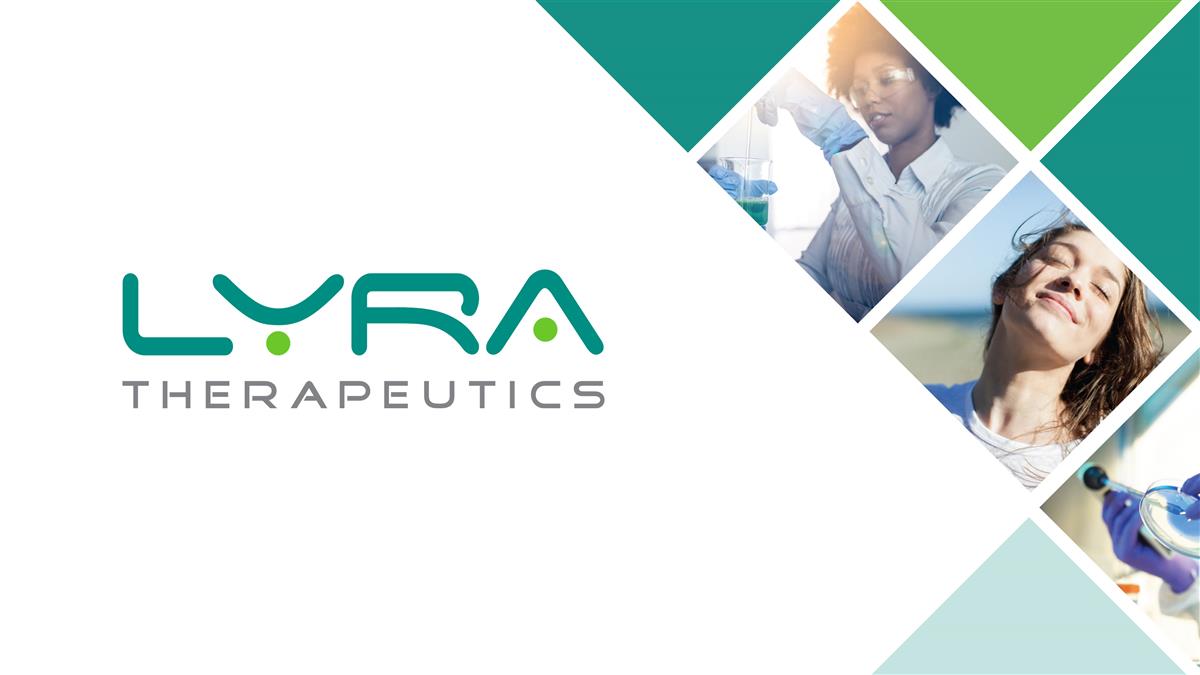UNITED STATES
SECURITIES AND EXCHANGE COMMISSION
WASHINGTON, D.C. 20549
FORM 8-K
CURRENT REPORT
Pursuant to Section 13 or 15(d)
of the Securities Exchange Act of 1934
Date of Report (Date of earliest event reported): May 27, 2025
Lyra Therapeutics, Inc.
(Exact name of Registrant as Specified in Its Charter)
| Delaware | 001-39273 | 84-1700838 | ||
| (State or Other Jurisdiction of Incorporation) |
(Commission File Number) |
(IRS Employer Identification No.) |
| 480 Arsenal Way Watertown, Massachusetts |
02472 | |||
| (Address of Principal Executive Offices) | (Zip Code) | |||
Registrant’s Telephone Number, Including Area Code: 617 393-4600
N/A
(Former Name or Former Address, if Changed Since Last Report)
Check the appropriate box below if the Form 8-K filing is intended to simultaneously satisfy the filing obligation of the registrant under any of the following provisions:
| ☐ | Written communications pursuant to Rule 425 under the Securities Act (17 CFR 230.425) |
| ☐ | Soliciting material pursuant to Rule 14a-12 under the Exchange Act (17 CFR 240.14a-12) |
| ☐ | Pre-commencement communications pursuant to Rule 14d-2(b) under the Exchange Act (17 CFR 240.14d-2(b)) |
| ☐ | Pre-commencement communications pursuant to Rule 13e-4(c) under the Exchange Act (17 CFR 240.13e-4(c)) |
Securities registered pursuant to Section 12(b) of the Act:
| Title of each class |
Trading |
Name of each exchange on which registered |
||
| Common Stock, $0.001 par value per share | LYRA | The Nasdaq Capital Market |
Indicate by check mark whether the registrant is an emerging growth company as defined in Rule 405 of the Securities Act of 1933 (§ 230.405 of this chapter) or Rule 12b-2 of the Securities Exchange Act of 1934 (§ 240.12b-2 of this chapter).
Emerging growth company ☒
If an emerging growth company, indicate by check mark if the registrant has elected not to use the extended transition period for complying with any new or revised financial accounting standards provided pursuant to Section 13(a) of the Exchange Act. ☐
| Item 5.03 | Amendment to Articles of Incorporation or Bylaws; Change in Fiscal Year. |
On May 27, 2025, Lyra Therapeutics, Inc. (the “Company”) filed a Certificate of Amendment to its Restated Certificate of Incorporation, as amended (the “Charter Amendment”) with the Secretary of State of the State of Delaware to effect a 1-for-50 reverse stock split (the “Reverse Stock Split”) of the Company’s common stock, par value $0.001 per share (the “Common Stock”), effective May 27, 2025 at 5:00 p.m., Eastern Time (the “Effective Time”) and the Company’s shares of Common Stock began trading on a split-adjusted basis on The Nasdaq Capital Market at the commencement of trading on May 28, 2025, under the Company’s existing trading symbol “LYRA”. The new CUSIP number for the Common Stock following the Reverse Stock Split is 55234L 204.
As previously reported, the Reverse Stock Split was approved by the Company’s stockholders at the Company’s annual meeting of stockholders held on May 14, 2025, at a ratio ranging from any whole number between 1-for-10 and 1-for-50, as determined by the Company’s board of directors (the “Board”) in its discretion. On May 14, 2025, the Board approved a ratio of 1-for-50 for the Reverse Stock Split and abandoned all other amendments.
The Charter Amendment provides that at the Effective Time, every 50 shares of the Company’s issued and outstanding shares of Common Stock immediately prior to the Effective Time, will be automatically converted, without any action on the part of the holder thereof, into one share of Common Stock. The number of authorized shares of Common Stock and the par value of each share of Common Stock remain unchanged. No fractional shares will be issued as a result of the Reverse Stock Split. Stockholders who otherwise would be entitled to receive a fractional share in connection with the Reverse Stock Split will receive a cash payment in lieu thereof.
The foregoing description is qualified in its entirety by the Charter Amendment, a copy of which is filed as Exhibit 3.1 to this Current Report on Form 8-K (the “Current Report”) and is incorporated herein by reference.
| Item 7.01 | Regulation FD Disclosure. |
On June 2, 2025, the Company issued a press release disclosing data from the ENLIGHTEN 2 Phase 3 Trial of LYR-210, which is furnished as Exhibit 99.1 to this Current Report and is incorporated herein by reference.
The information in Item 7.01 of this Current Report and Exhibit 99.1 hereto is intended to be furnished and shall not be deemed “filed” for purposes of Section 18 of the Securities Exchange Act of 1934, as amended (the “Exchange Act”), or otherwise subject to the liabilities of that section, nor shall it be deemed incorporated by reference in any filing under the Securities Act of 1933, as amended, or the Exchange Act, except as expressly set forth by specific reference in such filing.
| Item 8.01 | Other Events. |
On June 2, 2025, the Company posted an updated corporate presentation on the Company’s website which includes data from the ENLIGHTEN 2 Phase 3 Trial of LYR-210 demonstrating that the trial met its primary endpoint and key secondary endpoints for the treatment of chronic rhinosinusitis at 24 weeks. The corporate presentation is attached as Exhibit 99.2 to this Current Report and is incorporated herein by reference.
| Item 9.01 | Financial Statements and Exhibits. |
(d) Exhibits
| Exhibit |
Description |
|
| 3.1 | Certificate of Amendment to Restated Certificate of Incorporation of Lyra Therapeutics, Inc., dated May 27, 2025. | |
| 99.1 | Press Release issued on June 2, 2025. | |
| 99.2 | Corporate Presentation by Lyra Therapeutics, Inc. | |
| 104 | Cover Page Interactive Data File (embedded within the Inline XBRL document) | |
Cautionary Note Regarding Forward-Looking Statements
This Current Report on Form 8-K contains forward-looking statements within the meaning of the Private Securities Litigation Reform Act of 1995. All statements contained in this Current Report on Form 8-K that do not relate to matters of historical fact should be considered forward-looking statements, including without limitation statements regarding the trading of the Common Stock on a split-adjusted basis. These statements are neither promises nor guarantees, but involve known and unknown risks, uncertainties and other important factors that may cause our actual results, performance or achievements to be materially different from any future results, performance or achievements expressed or implied by the forward-looking statements. In some cases, you can identify forward-looking statements by terms such as “may,” “will,” “should,” “expect,” “plan,” “anticipate,” “could,” “intend,” “target,” “project,” “contemplate,” “believe,” “estimate,” “predict,” “potential,” “would” or “continue” or the negative of these terms or other similar expressions, although not all forward-looking statements contain these words or expressions. For other important factors that could cause actual results to differ materially from the forward-looking statements in this Current Report on Form 8-K, please see the risks and uncertainties identified under the heading “Risk Factors” in our Annual Report on Form 10-K for the year ended December 31, 2024, as updated by the Company’s Quarterly Report on Form 10-Q for the quarter ended March 31, 2025, each of which is available on the Company’s Investor Relations website at investors.lyratherapeutics.com and on the SEC website at www.sec.gov. Because forward-looking statements are inherently subject to risks and uncertainties, some of which cannot be predicted or quantified and some of which are beyond our control, you should not rely on these forward-looking statements as predictions of future events. The events and circumstances reflected in our forward-looking statements may not be achieved or occur and actual results could differ materially from those projected in the forward-looking statements. All forward-looking statements reflect the Company’s beliefs and assumptions only as of the date of this Current Report on Form 8-K. Except as required by applicable law, we do not plan to publicly update or revise any forward-looking statements contained herein, whether as a result of any new information, future events, changed circumstances, or otherwise. Capitalized terms shall have the meanings ascribed to such terms in this Current Report on Form 8-K.
SIGNATURES
Pursuant to the requirements of the Securities Exchange Act of 1934, the registrant has duly caused this report to be signed on its behalf by the undersigned hereunto duly authorized.
| Lyra Therapeutics, Inc. | ||||||
| Date: June 2, 2025 | By: | /s/ Jason Cavalier |
||||
| Jason Cavalier | ||||||
| Chief Financial Officer | ||||||
Exhibit 3.1
CERTIFICATE OF AMENDMENT
TO
RESTATED CERTIFICATE OF INCORPORATION
OF
LYRA THERAPEUTICS, INC.
Pursuant to Section 242 of the
General Corporation Law of the State of Delaware
Lyra Therapeutics, Inc. (the “Corporation”), a corporation organized and existing under and by virtue of the General Corporation Law of the State of Delaware,
DOES HEREBY CERTIFY THAT:
| 1. | The Board of Directors of the Corporation duly adopted resolutions at a meeting recommending and declaring advisable that the Restated Certificate of Incorporation of the Corporation, as amended, be further amended and that such amendment be submitted to the stockholders of the Corporation for their consideration, as follows: |
RESOLVED, that the first paragraph of Article FOURTH is being amended to read as follows:
“That, effective as of 5 p.m. Eastern Time on the date this Certificate of Amendment of Restated Certificate of Incorporation is filed with the Office of the Secretary of State of the State of Delaware (the “Effective Time”), a one-for-fifty reverse stock split of the Corporation’s Common Stock (as defined below) shall become effective, pursuant to which each fifty shares of Common Stock outstanding and held of record by each stockholder of the Corporation (including treasury shares) immediately prior to the Effective Time shall be reclassified and combined into one validly issued, fully-paid and nonassessable share of Common Stock automatically and without any action by the holder thereof upon the Effective Time and shall represent one share of Common Stock from and after the Effective Time (such reclassification and combination of shares, the “Reverse Stock Split”). The par value of the Common Stock following the Reverse Stock Split shall remain at $0.001 per share. No fractional shares of Common Stock shall be issued as a result of the Reverse Stock Split. In lieu thereof, (i) with respect to holders of one or more certificates which formerly represented shares of Common Stock that were issued and outstanding immediately prior to the Effective Time, upon surrender after the Effective Time of such certificate or certificates, any holder who would otherwise be entitled to a fractional share of Common Stock as a result of the Reverse Stock Split, following the Effective Time, shall be entitled to receive a cash payment (the “Fractional Share Payment”) equal to the fraction of which such holder would otherwise be entitled multiplied by the closing price per share as reported by The Nasdaq Capital Market (as adjusted to give effect to the Reverse Stock Split) on the date of the Effective Time; provided that, whether or not fractional shares would be issuable as a result of the Reverse Stock Split shall be determined on the basis of (a) the total number of shares of Common Stock that were issued and outstanding immediately prior to the Effective Time formerly represented by certificates that the holder is at the time surrendering and (b) the aggregate number of shares of Common Stock after the Effective Time into which the shares of Common Stock formerly represented by such certificates shall have been reclassified; and (ii) with respect to holders of shares of Common Stock in book-entry form in the records of the Company’s transfer agent that were issued and outstanding immediately prior to the Effective Time, any holder who would otherwise be entitled to a fractional share of Common Stock as a result of the Reverse Stock Split, following the Effective Time, shall be entitled to receive the Fractional Share Payment automatically and without any action by the holder.
The total number of shares of all classes of stock which the Corporation shall have authority to issue is 210,000,000 shares, consisting of (a) 200,000,000 shares of Common Stock, $0.001 par value per share (“Common Stock”), and (b) 10,000,000 shares of Preferred Stock, $0.001 par value per share (“Preferred Stock”).”
| 2. | The stockholders of the Corporation duly adopted such amendment at an annual meeting of the stockholders of the Corporation. |
| 3. | Such amendment has been duly adopted in accordance with Section 242 of the General Corporation Law of the State of Delaware. |
IN WITNESS WHEREOF, this Certificate of Amendment to Amended and Restated Certificate of Incorporation has been executed by a duly authorized officer of the Corporation on this 27th day of May, 2025.
| By: | /s/ Maria Palasis |
|
| Name: | Maria Palasis | |
| Title: | President and Chief Executive Officer |
Exhibit 99.1
Lyra Therapeutics Reports Positive Results from the ENLIGHTEN 2 Phase 3 Trial of LYR-210 Achieving Statistically Significant Results for Primary and Key Secondary Endpoints in the Treatment of Chronic Rhinosinusitis (CRS)
| • | ENLIGHTEN 2 trial met primary endpoint with LYR-210 demonstrating statistically significant improvement in the composite of the three cardinal symptoms (3CS) of CRS at 24 weeks (p=0.0078) |
| • | ENLIGHTEN 2 trial also showed statistically significant improvement in key secondary endpoints in the full population of 3CS at 24 weeks (p=0.0209) and SNOT-22 score at 24 weeks (p=0.0101) |
| • | Additionally, in pooled data from ENLIGHTEN 2 and ENLIGHTEN 1 trials in 64 CRS patients with nasal polyps, LYR-210 demonstrated a consistent positive trend over 24 weeks in multiple key efficacy endpoints |
| • | Lyra plans to review the totality of the dataset from the ENLIGHTEN trials to evaluate next steps for pursuing an indication in non-polyp patients, as well as to continue development of LYR-210 in patients with nasal polyps |
| • | Conference call to discuss trial results today at 8:30 a.m. ET |
WATERTOWN, Mass., June 2, 2025 – Lyra Therapeutics, Inc. (Nasdaq: LYRA) (“Lyra” or the “Company”), a clinical-stage biotechnology company developing long-acting, anti-inflammatory sinonasal implants for the treatment of chronic rhinosinusitis (CRS), today announced positive results from the ENLIGHTEN 2 Phase 3 clinical trial of LYR-210 in adult patients with CRS. The ENLIGHTEN 2 trial met its primary endpoint, with LYR-210 demonstrating statistically significant improvement compared to sham control in a composite of the three cardinal symptoms (3CS) of CRS (nasal obstruction, nasal discharge, facial pain/pressure) at week 24 (-1.13; p=0.0078) in patients without nasal polyps.
The ENLIGHTEN 2 trial also met the key secondary endpoints of 3CS at 24 weeks in the full population (i.e., patients with and without nasal polyps) (-0.90; p=0.0209) and in the clinically-validated SNOT-22 score at 24 weeks (-8.7; p=0.0101), with symptom improvement observed as early as week 4. Consistent with previous studies, LYR-210 was well-tolerated, with a safety profile similar to sham control.
The ENLIGHTEN program consists of two Phase 3 clinical trials, ENLIGHTEN 1 and ENLIGHTEN 2, to evaluate the efficacy and safety of LYR-210 for the treatment of CRS. While the ENLIGHTEN 2 trial met its primary endpoint and key secondary endpoints, the ENLIGHTEN 1 trial did not meet the primary endpoint or secondary endpoints, as previously reported in May 2024. Each ENLIGHTEN trial has enrolled approximately 180 CRS patients who have failed medical management and have not had prior ethmoid sinus surgery, randomized 2:1 to either LYR-210 (7500µg mometasone furoate) or sham control. The 24-week endpoints in the ENLIGHTEN trials assess LYR-210’s long-acting therapeutic effect as a bioresorbable nasal implant designed to deliver six months of continuous anti-inflammatory medication to the sinonasal passages.
Results for Primary and Key Secondary Endpoints from ENLIGHTEN 2 Phase 3 Trial
Patients reported LYR-210 significantly improved important outcome measures on primary and key secondary endpoints:
| • | Statistically significant improvement compared to sham control in a composite of the 3CS of CRS at week 24 (-1.13; p=0.0078) in patients without nasal polyps. |
| • | Statistically significant improvement in 3CS with LYR-210 compared to sham control at week 24 (-0.90; p=0.0209) in the full population (i.e., patients with and without nasal polyps) |
| • | Statistically significant improvements in Sino-Nasal Outcome Test (SNOT-22) score with LYR-210 compared to sham control at week 24 (-8.7; p=0.0101) |
| • | Improvements in SNOT-22 were observed as early as week 4 with LYR-210 compared to sham control (-6.4; p=0.0456) |
| • | Improvements in SNOT-22 were sustained throughout the trial and were clinically meaningful, with more than twice the minimal clinically important difference observed at week 24 compared to baseline in the LYR-210 group (-22.4 points) |
| • | Data evaluating computed tomography (CT) scans demonstrated numerical improvement in ethmoid sinus opacification in patients who received LYR-210, compared to sham control at week 20 (-2.15; p=0.1809). These data provide objective radiological evidence of improvement with LYR-210 treatment. |
| • | LYR-210 patients showed no difference from sham patients in use of corticosteroid rescue medication; however, the LYR-210 patients had fewer endoscopic sinus surgeries compared to sham control. |
LYR-210 was well tolerated, with no product-related serious adverse events in the ENLIGHTEN 2 trial. The most commonly reported adverse events included epistaxis, upper respiratory tract infection, chronic sinusitis, acute sinusitis, nasopharyngitis, COVID-19, and headache.
Results for CRS Patents with Nasal Polyps in Pooled Analysis from ENLIGHTEN 1 and ENLIGHTEN 2
Additionally, Lyra conducted a pooled data analysis of a total of 64 CRS patients with small nasal polyps (grade 1) from the ENLIGHTEN 1 and ENLIGHTEN 2 trials. The data demonstrated a consistent positive trend compared to sham control over 24 weeks in multiple endpoints:
| • | Improvement in 3CS with LYR-210 compared to sham control at week 24 (-1.13; p=0.0837), starting as early as week 4. |
| • | Improvement in SNOT-22 score with LYR-210 compared to sham control at week 24 (-8.7; p=0.1331), starting as early as week 4. |
| • | Improvements in percent ethmoid opacification with LYR-210 compared to sham control at week 20 (-6.07; p=0.1127). |
| • | Improvements in nasal congestion score (NCS) with LYR-210 compared to sham control at week 24 for patients with moderate to severe NCS at baseline (-0.33; p=0.2159), starting as early as week 4. |
| • | Improvements in nasal polyp score with LYR-210 compared to sham control at week 24 (-0.16; p=0.3494). |
“We are thrilled to announce these positive results from our ENLIGHTEN 2 trial. We believe this has the potential to provide a path to advance LYR-210 to treat CRS, offering six months of therapy in a single administration for millions of patients who do not respond to standard CRS medical management. We will continue to review the totality of the dataset from the ENLIGHTEN trials to optimize our regulatory strategy,” said Maria Palasis, Ph.D., President and CEO, Lyra Therapeutics. “Given these data we reported today, we plan to align with the FDA on a path forward for an NDA submission in patients without nasal polyps. As planned, we also analyzed the pooled data from ENLIGHTEN 2 and ENLIGHTEN 1 trials to treat CRS patients with nasal polyps, and we believe this positive data positions us to proceed with a development plan in patients with nasal polyps, based on our alignment in December 2024 with FDA on endpoints, inclusion criteria, patient population, background therapy, and assessments. Looking further ahead, we envision LYR-210 achieving its potential to benefit both non-polyp and polyp patients, positioning us to become a leader in CRS and validating our platform for future ENT indications.”
“The positive results seen in the ENLIGHTEN 2 study are impressive and represent what could be a promising new treatment approach for the many CRS patients that I see every day in my practice who are underserved by limited therapies.,” said Zachary Soler, M.D., MSc, Professor in the Department of Otolaryngology-Head and Neck Surgery at the Medical University of South Carolina and coordinating Lead Investigator for the ENLIGHTEN 2 trial. “The more than 20-point improvement from baseline in SNOT-22 score after LYR-210 treatment represents a clinically meaningful improvement in patient symptoms.”
“These positive results represent a significant milestone in advancing an innovative treatment to CRS patients who suffer from this chronic condition. It’s a proud moment for us and a testament to the dedication of this team and our investigators in the development of this novel therapy.”, said Harlan Waksal, M.D., Executive Chairman, Lyra Therapeutics.
Results from the ENLIGHTEN 2 trial of LYR-210 are planned to be presented at the 71st Annual Meeting of the American Rhinologic Society, October 2025.
Conference Call and Webcast
Lyra Therapeutics will host a conference call and webcast to discuss results from the ENLIGHTEN 2 trial today, June 2, 2025, beginning at 8:30 a.m. ET. To join the audio call please register via this audio link, or to view the livestreamed webcast visit this webcast link. A replay of the webcast and presentation will be available following the conference call in “Events and Presentations” in the Investors section of Lyra’s website for a limited time.
About LYR-210
LYR-210 is an investigational product candidate for the treatment of chronic rhinosinusitis (CRS) in patients who have failed current therapies and require further intervention. LYR-210 is a bioabsorbable nasal implant designed to be inserted in a simple, in-office procedure. LYR-210 is intended to deliver six months of continuous anti-inflammatory therapy, mometasone furoate, to the sinonasal passages to treat CRS.
About Lyra Therapeutics
Lyra Therapeutics, Inc. is a clinical-stage biotechnology company developing long-acting, anti-inflammatory sinonasal implants for the treatment of chronic rhinosinusitis (CRS). Lyra Therapeutics is developing therapies for CRS, a highly prevalent inflammatory disease of the paranasal sinuses which leads to debilitating symptoms and significant morbidities. LYR-210, the company’s lead product, is a bioabsorbable nasal implant designed to be administered in a simple, in-office procedure and is intended to deliver six months of continuous anti-inflammatory drug therapy (7500µg mometasone furoate) to the sinonasal passages for the treatment of CRS with a single administration.
LYR-210, which was evaluated in the ENLIGHTEN Phase 3 clinical program, is intended for patients with and without nasal polyps. The company’s therapies are intended to treat the estimated four million CRS patients in the United States who fail medical management each year. For more information, please visit www.lyratx.com and follow us on LinkedIn.
Forward-Looking Statements
This press release contains forward-looking statements within the meaning of the Private Securities Litigation Reform Act of 1995. The words “believe,” “may,” “will,” “estimate,” “envision,” “continue,” “anticipate,” “intend,” “expect,” and similar expressions are intended to identify forward-looking statements. All statements contained in this press release that do not relate to matters of historical fact should be considered forward-looking statements, including statements regarding our evaluation and investigation of the ENLIGHTEN 2 results and how they inform our path forward, our planned regulatory interaction and path for LYR-210, including alignment with the FDA and any planned regulatory submissions, our ability to design, implement and complete a new Phase 3 trial, the expected label for LYR-210, whether the pooled results from ENLIGHTEN 1 and 2 would support a path forward to a pivotal study in CRSwNP, our ability to correctly interpret FDA guidance received in December 2024 including on endpoints, inclusion criteria, patient population, background therapy, and assessments, whether LYR-210, if advanced, would be positioned to align with current ENT practices, and statements regarding the potential market opportunity for LYR-210, our participation in future events and presentations, and the timing of any of the foregoing. These statements are neither promises nor guarantees, but involve known and unknown risks, uncertainties and other important factors that may cause the Company’s actual results, performance or achievements to be materially different from any future results, performance or achievements expressed or implied by the forward-looking statements, including, but not limited to, the following: the Company’s failure to meet its primary endpoint in its ENLIGHTEN 1 Phase 3 clinical trial; the fact the Company terminated the employment of approximately 87 employees following the announcement that it failed to attain the primary endpoint of its ENLIGHTEN 1 Phase 3 clinical trial; the fact that the Company has incurred significant losses since inception and expects to incur additional losses for the foreseeable future; the Company’s need for additional funding, which may not be available; the fact that the Company needs to conduct at least one additional phase 3 clinical trial; the Company’s ability to continue as a going concern; the Company’s limited operating history; the fact that the Company has no approved products; the fact that clinical trial data is subject to change until the completion of the applicable clinical study report; the fact that clinical trials required for the Company’s product candidates are expensive and time-consuming, and their outcome is uncertain; effects of recently enacted and future legislation; the possibility of system failures or security breaches; effects of significant competition; the Company’s reliance on third parties to conduct its preclinical studies and clinical trials; failure to obtain and maintain or adequately protect the Company’s intellectual property rights; failure to retain key personnel; the fact that the price of the Company’s common stock may be volatile and fluctuate substantially; significant costs and required management time as a result of operating as a public company and any securities class action litigation. These and other important factors discussed under the caption “Risk Factors” in the Company’s Quarterly Report on Form 10-Q filed with the SEC on May 6, 2025 and its other filings with the SEC could cause actual results to differ materially from those indicated by the forward-looking statements made in this press release. Any such forward-looking statements represent management’s estimates as of the date of this press release. While the Company may elect to update such forward-looking statements at some point in the future, it disclaims any obligation to do so, even if subsequent events cause its views to change.
Contact Information:
Jason Cavalier
Chief Financial Officer
917.584.7668
jcavalier@lyratx.com
Media Contact:
Kathryn Morris
The Yates Network LLC
914.204.6412
kathryn@theyatesnetwork.com
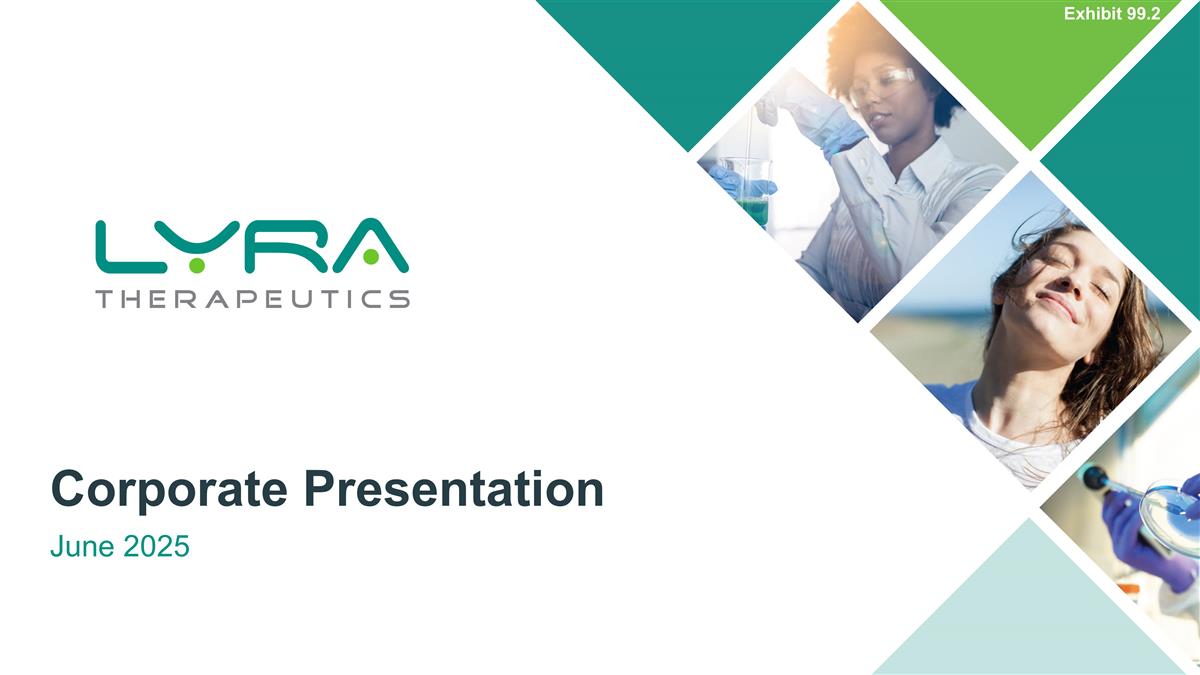
Corporate Presentation June 2025 Exhibit 99.2
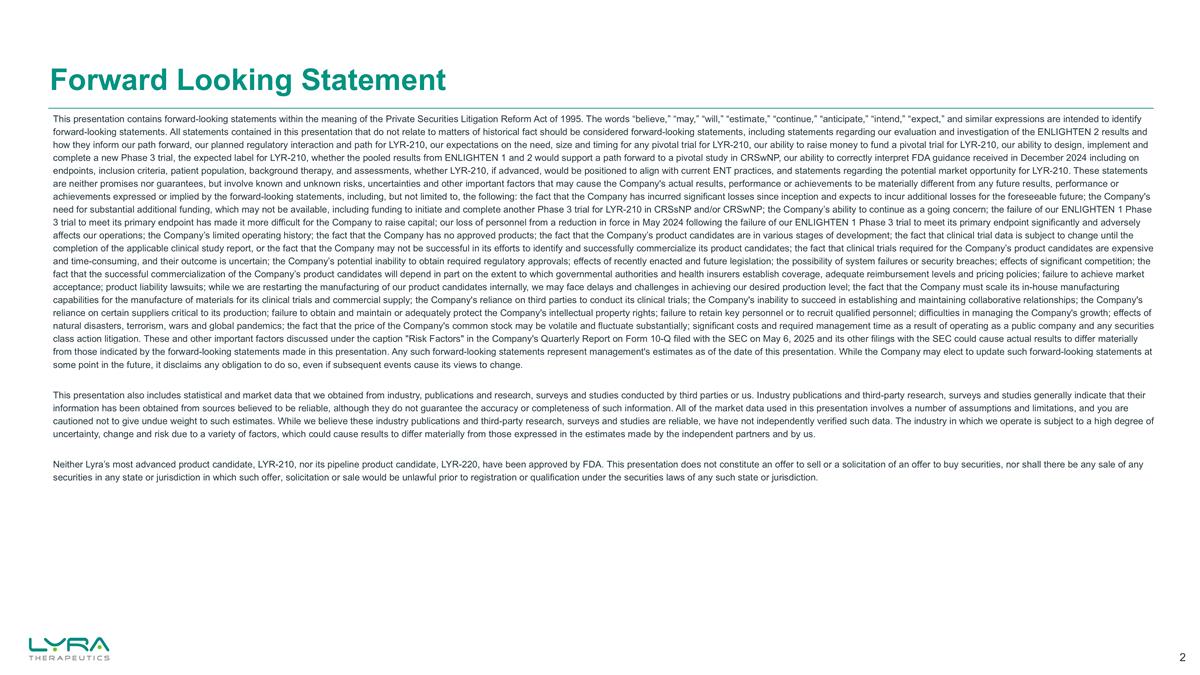
Forward Looking Statement This presentation contains forward-looking statements within the meaning of the Private Securities Litigation Reform Act of 1995. The words “believe,” “may,” “will,” “estimate,” “continue,” “anticipate,” “intend,” “expect,” and similar expressions are intended to identify forward-looking statements. All statements contained in this presentation that do not relate to matters of historical fact should be considered forward-looking statements, including statements regarding our evaluation and investigation of the ENLIGHTEN 2 results and how they inform our path forward, our planned regulatory interaction and path for LYR-210, our expectations on the need, size and timing for any pivotal trial for LYR-210, our ability to raise money to fund a pivotal trial for LYR-210, our ability to design, implement and complete a new Phase 3 trial, the expected label for LYR-210, whether the pooled results from ENLIGHTEN 1 and 2 would support a path forward to a pivotal study in CRSwNP, our ability to correctly interpret FDA guidance received in December 2024 including on endpoints, inclusion criteria, patient population, background therapy, and assessments, whether LYR-210, if advanced, would be positioned to align with current ENT practices, and statements regarding the potential market opportunity for LYR-210. These statements are neither promises nor guarantees, but involve known and unknown risks, uncertainties and other important factors that may cause the Company's actual results, performance or achievements to be materially different from any future results, performance or achievements expressed or implied by the forward-looking statements, including, but not limited to, the following: the fact that the Company has incurred significant losses since inception and expects to incur additional losses for the foreseeable future; the Company's need for substantial additional funding, which may not be available, including funding to initiate and complete another Phase 3 trial for LYR-210 in CRSsNP and/or CRSwNP; the Company’s ability to continue as a going concern; the failure of our ENLIGHTEN 1 Phase 3 trial to meet its primary endpoint has made it more difficult for the Company to raise capital; our loss of personnel from a reduction in force in May 2024 following the failure of our ENLIGHTEN 1 Phase 3 trial to meet its primary endpoint significantly and adversely affects our operations; the Company’s limited operating history; the fact that the Company has no approved products; the fact that the Company’s product candidates are in various stages of development; the fact that clinical trial data is subject to change until the completion of the applicable clinical study report, or the fact that the Company may not be successful in its efforts to identify and successfully commercialize its product candidates; the fact that clinical trials required for the Company’s product candidates are expensive and time-consuming, and their outcome is uncertain; the Company’s potential inability to obtain required regulatory approvals; effects of recently enacted and future legislation; the possibility of system failures or security breaches; effects of significant competition; the fact that the successful commercialization of the Company’s product candidates will depend in part on the extent to which governmental authorities and health insurers establish coverage, adequate reimbursement levels and pricing policies; failure to achieve market acceptance; product liability lawsuits; while we are restarting the manufacturing of our product candidates internally, we may face delays and challenges in achieving our desired production level; the fact that the Company must scale its in-house manufacturing capabilities for the manufacture of materials for its clinical trials and commercial supply; the Company's reliance on third parties to conduct its clinical trials; the Company's inability to succeed in establishing and maintaining collaborative relationships; the Company's reliance on certain suppliers critical to its production; failure to obtain and maintain or adequately protect the Company's intellectual property rights; failure to retain key personnel or to recruit qualified personnel; difficulties in managing the Company's growth; effects of natural disasters, terrorism, wars and global pandemics; the fact that the price of the Company's common stock may be volatile and fluctuate substantially; significant costs and required management time as a result of operating as a public company and any securities class action litigation. These and other important factors discussed under the caption "Risk Factors" in the Company's Quarterly Report on Form 10-Q filed with the SEC on May 6, 2025 and its other filings with the SEC could cause actual results to differ materially from those indicated by the forward-looking statements made in this presentation. Any such forward-looking statements represent management's estimates as of the date of this presentation. While the Company may elect to update such forward-looking statements at some point in the future, it disclaims any obligation to do so, even if subsequent events cause its views to change. This presentation also includes statistical and market data that we obtained from industry, publications and research, surveys and studies conducted by third parties or us. Industry publications and third-party research, surveys and studies generally indicate that their information has been obtained from sources believed to be reliable, although they do not guarantee the accuracy or completeness of such information. All of the market data used in this presentation involves a number of assumptions and limitations, and you are cautioned not to give undue weight to such estimates. While we believe these industry publications and third-party research, surveys and studies are reliable, we have not independently verified such data. The industry in which we operate is subject to a high degree of uncertainty, change and risk due to a variety of factors, which could cause results to differ materially from those expressed in the estimates made by the independent partners and by us. Neither Lyra’s most advanced product candidate, LYR-210, nor its pipeline product candidate, LYR-220, have been approved by FDA. This presentation does not constitute an offer to sell or a solicitation of an offer to buy securities, nor shall there be any sale of any securities in any state or jurisdiction in which such offer, solicitation or sale would be unlawful prior to registration or qualification under the securities laws of any such state or jurisdiction.
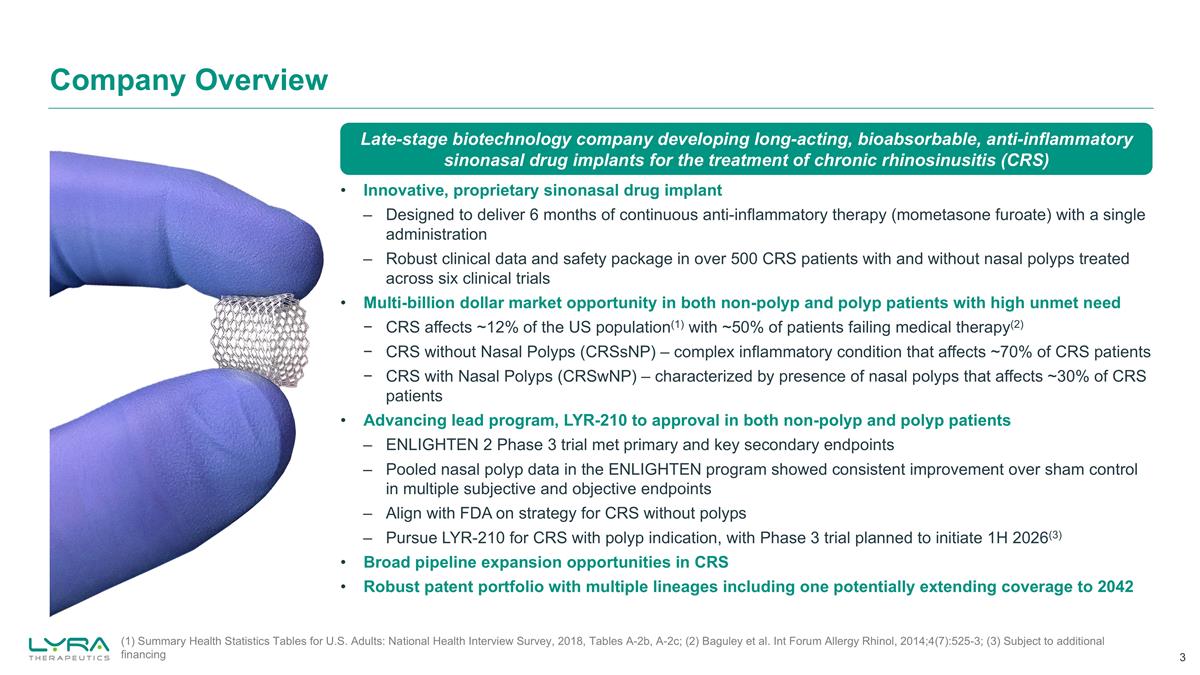
(1) Summary Health Statistics Tables for U.S. Adults: National Health Interview Survey, 2018, Tables A-2b, A-2c; (2) Baguley et al. Int Forum Allergy Rhinol, 2014;4(7):525-3; (3) Subject to additional financing Company Overview Innovative, proprietary sinonasal drug implant Designed to deliver 6 months of continuous anti-inflammatory therapy (mometasone furoate) with a single administration Robust clinical data and safety package in over 500 CRS patients with and without nasal polyps treated across six clinical trials Multi-billion dollar market opportunity in both non-polyp and polyp patients with high unmet need CRS affects ~12% of the US population(1) with ~50% of patients failing medical therapy(2) CRS without Nasal Polyps (CRSsNP) – complex inflammatory condition that affects ~70% of CRS patients CRS with Nasal Polyps (CRSwNP) – characterized by presence of nasal polyps that affects ~30% of CRS patients Advancing lead program, LYR-210 to approval in both non-polyp and polyp patients ENLIGHTEN 2 Phase 3 trial met primary and key secondary endpoints Pooled nasal polyp data in the ENLIGHTEN program showed consistent improvement over sham control in multiple subjective and objective endpoints Align with FDA on strategy for CRS without polyps Pursue LYR-210 for CRS with polyp indication, with Phase 3 trial planned to initiate 1H 2026(3) Broad pipeline expansion opportunities in CRS Robust patent portfolio with multiple lineages including one potentially extending coverage to 2042 Late-stage biotechnology company developing long-acting, bioabsorbable, anti-inflammatory sinonasal drug implants for the treatment of chronic rhinosinusitis (CRS)
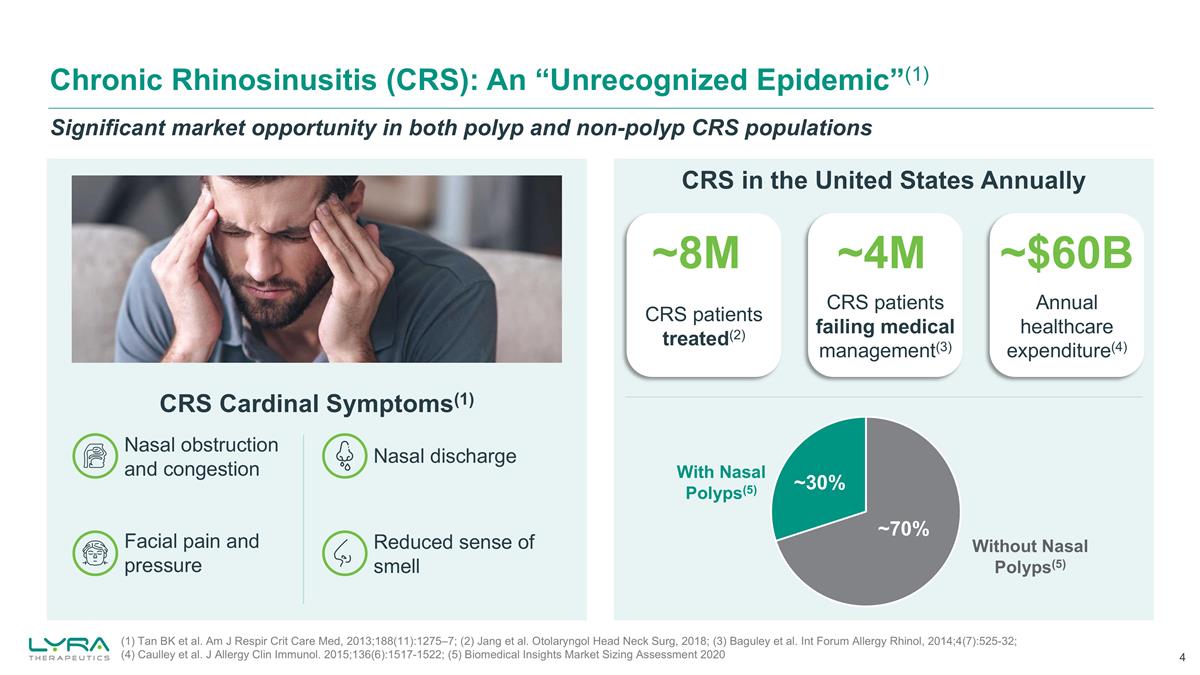
Chronic Rhinosinusitis (CRS): An “Unrecognized Epidemic”(1) CRS Cardinal Symptoms(1) Nasal obstruction and congestion Facial pain and pressure Nasal discharge Reduced sense of smell (1) Tan BK et al. Am J Respir Crit Care Med, 2013;188(11):1275–7; (2) Jang et al. Otolaryngol Head Neck Surg, 2018; (3) Baguley et al. Int Forum Allergy Rhinol, 2014;4(7):525-32; (4) Caulley et al. J Allergy Clin Immunol. 2015;136(6):1517-1522; (5) Biomedical Insights Market Sizing Assessment 2020 CRS in the United States Annually ~8M ~4M ~$60B ~30% ~70% With Nasal Polyps(5) Without Nasal Polyps(5) CRS patients treated(2) CRS patients failing medical management(3) Annual healthcare expenditure(4) Significant market opportunity in both polyp and non-polyp CRS populations
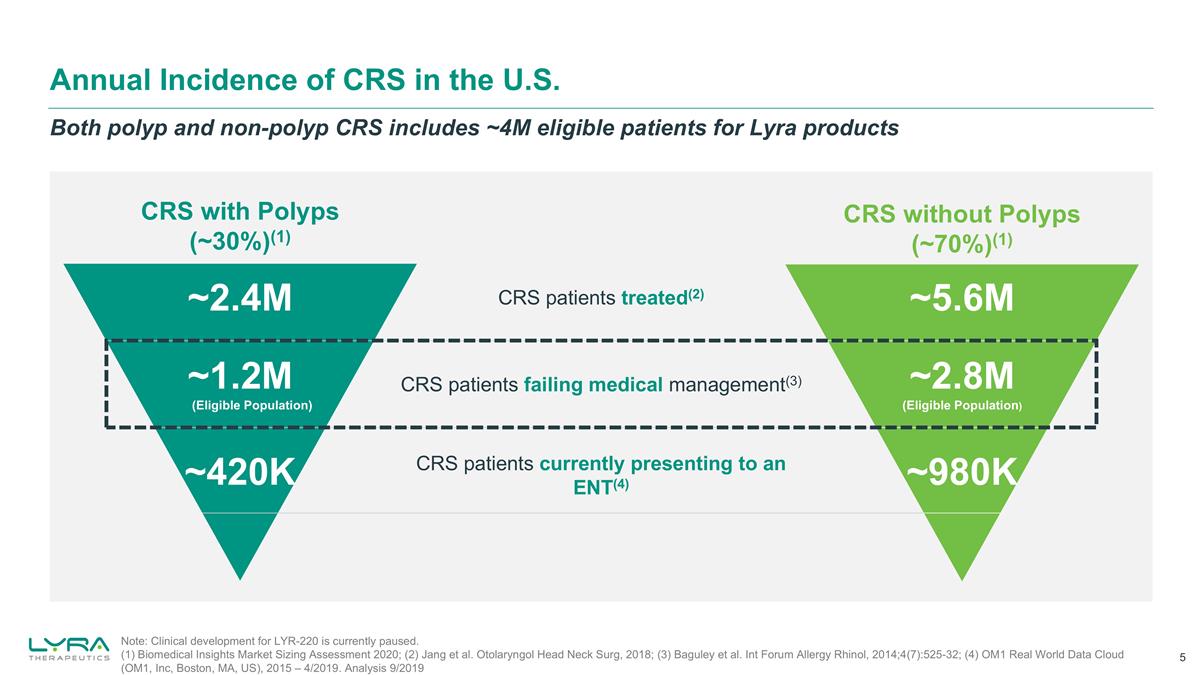
Note: Clinical development for LYR-220 is currently paused. (1) Biomedical Insights Market Sizing Assessment 2020; (2) Jang et al. Otolaryngol Head Neck Surg, 2018; (3) Baguley et al. Int Forum Allergy Rhinol, 2014;4(7):525-32; (4) OM1 Real World Data Cloud (OM1, Inc, Boston, MA, US), 2015 – 4/2019. Analysis 9/2019 Annual Incidence of CRS in the U.S. Both polyp and non-polyp CRS includes ~4M eligible patients for Lyra products CRS patients treated(2) CRS patients failing medical management(3) ~2.4M ~420K ~1.2M (Eligible Population) CRS patients currently presenting to an ENT(4) CRS with Polyps (~30%)(1) ~5.6M ~2.8M (Eligible Population) ~980K CRS without Polyps (~70%)(1)
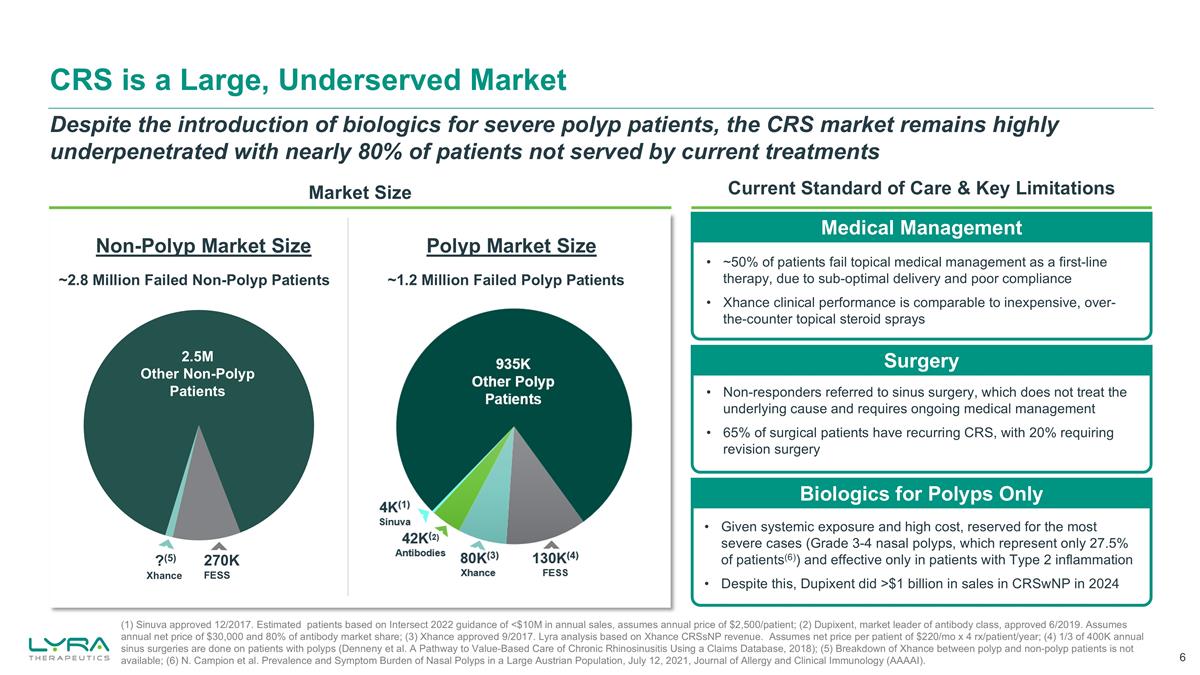
Despite the introduction of biologics for severe polyp patients, the CRS market remains highly underpenetrated with nearly 80% of patients not served by current treatments CRS is a Large, Underserved Market (1) Sinuva approved 12/2017. Estimated patients based on Intersect 2022 guidance of <$10M in annual sales, assumes annual price of $2,500/patient; (2) Dupixent, market leader of antibody class, approved 6/2019. Assumes annual net price of $30,000 and 80% of antibody market share; (3) Xhance approved 9/2017. Lyra analysis based on Xhance CRSsNP revenue. Assumes net price per patient of $220/mo x 4 rx/patient/year; (4) 1/3 of 400K annual sinus surgeries are done on patients with polyps (Denneny et al. A Pathway to Value-Based Care of Chronic Rhinosinusitis Using a Claims Database, 2018); (5) Breakdown of Xhance between polyp and non-polyp patients is not available; (6) N. Campion et al. Prevalence and Symptom Burden of Nasal Polyps in a Large Austrian Population, July 12, 2021, Journal of Allergy and Clinical Immunology (AAAAI). ~2.8 Million Failed Non-Polyp Patients Market Size Medical Management ` Surgery ` Biologics for Polyps Only ` ~50% of patients fail topical medical management as a first-line therapy, due to sub-optimal delivery and poor compliance Xhance clinical performance is comparable to inexpensive, over-the-counter topical steroid sprays Non-responders referred to sinus surgery, which does not treat the underlying cause and requires ongoing medical management 65% of surgical patients have recurring CRS, with 20% requiring revision surgery Given systemic exposure and high cost, reserved for the most severe cases (Grade 3-4 nasal polyps, which represent only 27.5% of patients(6)) and effective only in patients with Type 2 inflammation Despite this, Dupixent did >$1 billion in sales in CRSwNP in 2024 ~1.2 Million Failed Polyp Patients Non-Polyp Market Size Polyp Market Size 2.5M Other Non-Polyp Patients 270K FESS ?(5) Xhance Current Standard of Care & Key Limitations
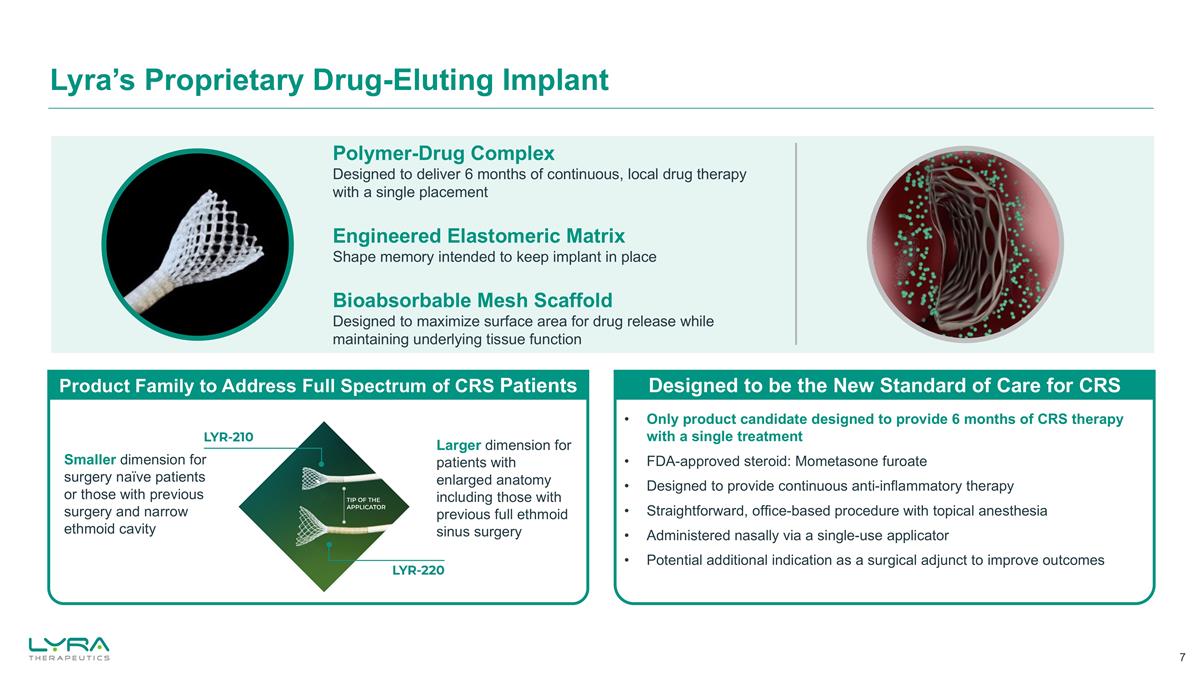
Lyra’s Proprietary Drug-Eluting Implant Engineered Elastomeric Matrix Shape memory intended to keep implant in place Polymer-Drug Complex Designed to deliver 6 months of continuous, local drug therapy with a single placement Bioabsorbable Mesh Scaffold Designed to maximize surface area for drug release while maintaining underlying tissue function Larger dimension for patients with enlarged anatomy including those with previous full ethmoid sinus surgery ` ` Designed to be the New Standard of Care for CRS Product Family to Address Full Spectrum of CRS Patients Only product candidate designed to provide 6 months of CRS therapy with a single treatment FDA-approved steroid: Mometasone furoate Designed to provide continuous anti-inflammatory therapy Straightforward, office-based procedure with topical anesthesia Administered nasally via a single-use applicator Potential additional indication as a surgical adjunct to improve outcomes Smaller dimension for surgery naïve patients or those with previous surgery and narrow ethmoid cavity
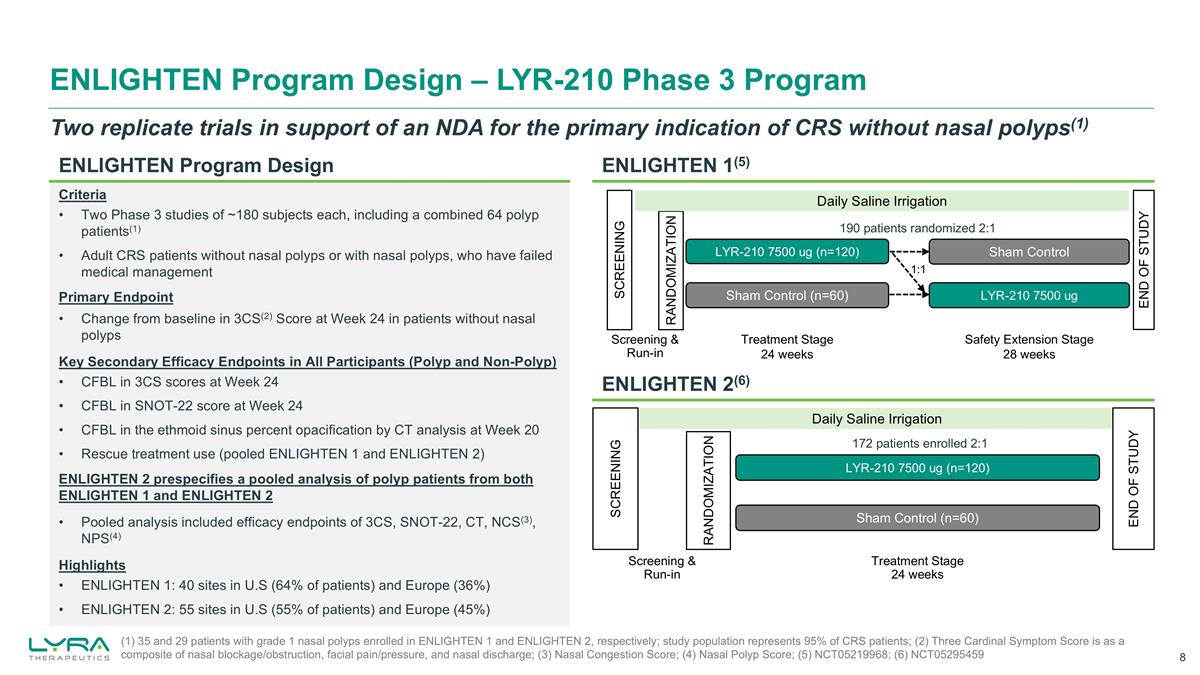
ENLIGHTEN Program Design – LYR-210 Phase 3 Program (1) 35 and 29 patients with grade 1 nasal polyps enrolled in ENLIGHTEN 1 and ENLIGHTEN 2, respectively; study population represents 95% of CRS patients; (2) Three Cardinal Symptom Score is as a composite of nasal blockage/obstruction, facial pain/pressure, and nasal discharge; (3) Nasal Congestion Score; (4) Nasal Polyp Score; (5) NCT05219968; (6) NCT05295459 ENLIGHTEN 2(6) ENLIGHTEN 1(5) Two replicate trials in support of an NDA for the primary indication of CRS without nasal polyps(1) Criteria Two Phase 3 studies of ~180 subjects each, including a combined 64 polyp patients(1) Adult CRS patients without nasal polyps or with nasal polyps, who have failed medical management Primary Endpoint Change from baseline in 3CS(2) Score at Week 24 in patients without nasal polyps Key Secondary Efficacy Endpoints in All Participants (Polyp and Non-Polyp) CFBL in 3CS scores at Week 24 CFBL in SNOT-22 score at Week 24 CFBL in the ethmoid sinus percent opacification by CT analysis at Week 20 Rescue treatment use (pooled ENLIGHTEN 1 and ENLIGHTEN 2) ENLIGHTEN 2 prespecifies a pooled analysis of polyp patients from both ENLIGHTEN 1 and ENLIGHTEN 2 Pooled analysis included efficacy endpoints of 3CS, SNOT-22, CT, NCS(3), NPS(4) Highlights ENLIGHTEN 1: 40 sites in U.S (64% of patients) and Europe (36%) ENLIGHTEN 2: 55 sites in U.S (55% of patients) and Europe (45%) Daily Saline Irrigation Sham Control (n=60) LYR-210 7500 ug (n=120) SCREENING RANDOMIZATION END OF STUDY Screening & Run-in 172 patients enrolled 2:1 Treatment Stage 24 weeks Sham Control Sham Control (n=60) LYR-210 7500 ug (n=120) LYR-210 7500 ug SCREENING RANDOMIZATION Treatment Stage 24 weeks Safety Extension Stage 28 weeks Screening & Run-in 1:1 190 patients randomized 2:1 Daily Saline Irrigation END OF STUDY ENLIGHTEN Program Design
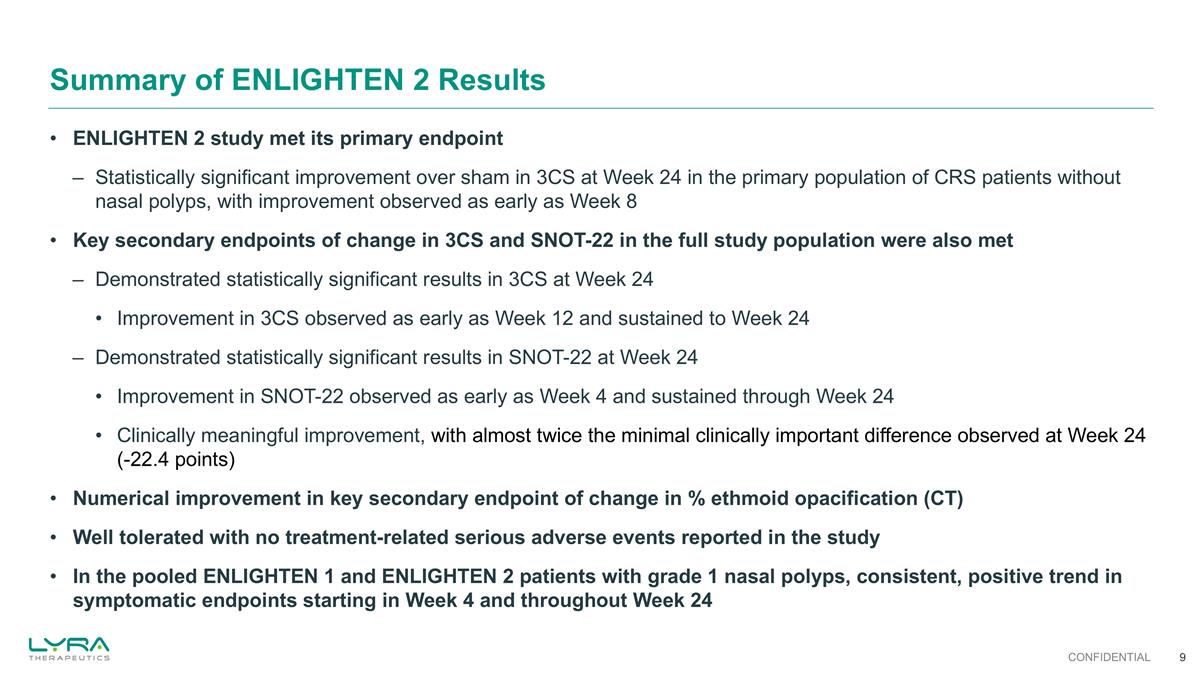
ENLIGHTEN 2 study met its primary endpoint Statistically significant improvement over sham in 3CS at Week 24 in the primary population of CRS patients without nasal polyps, with improvement observed as early as Week 8 Key secondary endpoints of change in 3CS and SNOT-22 in the full study population were also met Demonstrated statistically significant results in 3CS at Week 24 Improvement in 3CS observed as early as Week 12 and sustained to Week 24 Demonstrated statistically significant results in SNOT-22 at Week 24 Improvement in SNOT-22 observed as early as Week 4 and sustained through Week 24 Clinically meaningful improvement, with almost twice the minimal clinically important difference observed at Week 24 (-22.4 points) Numerical improvement in key secondary endpoint of change in % ethmoid opacification (CT) Well tolerated with no treatment-related serious adverse events reported in the study In the pooled ENLIGHTEN 1 and ENLIGHTEN 2 patients with grade 1 nasal polyps, consistent, positive trend in symptomatic endpoints starting in Week 4 and throughout Week 24 Summary of ENLIGHTEN 2 Results CONFIDENTIAL
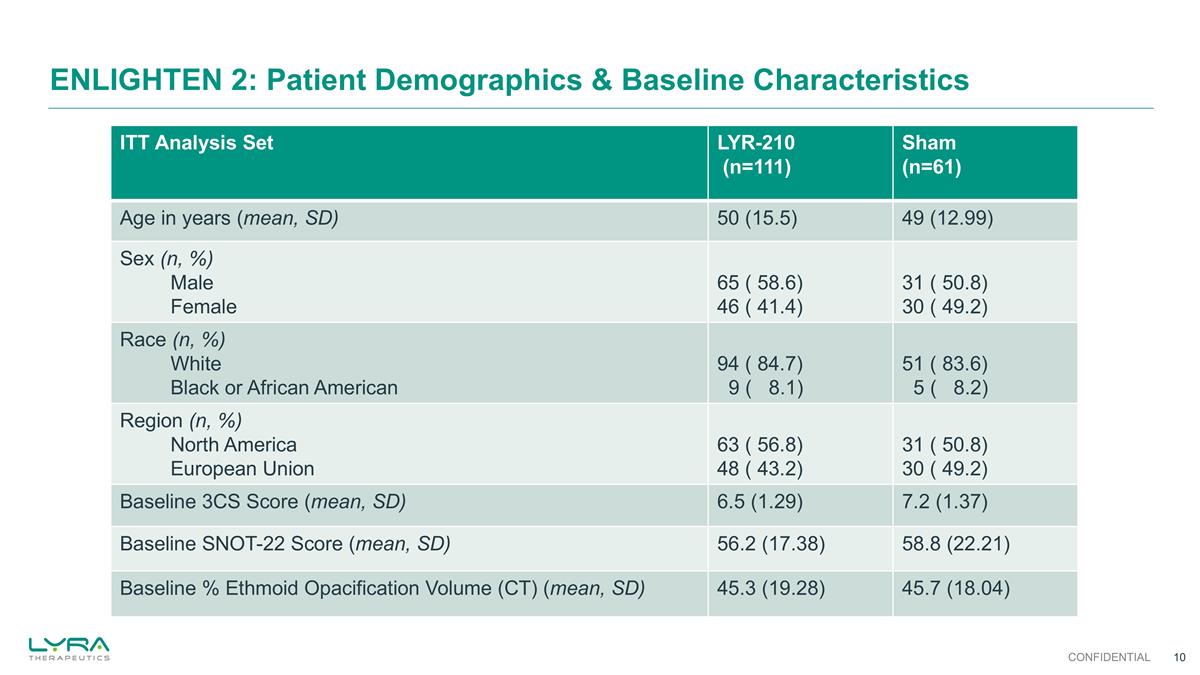
ENLIGHTEN 2: Patient Demographics & Baseline Characteristics CONFIDENTIAL ITT Analysis Set LYR-210 (n=111) Sham (n=61) Age in years (mean, SD) 50 (15.5) 49 (12.99) Sex (n, %) Male Female 65 ( 58.6) 46 ( 41.4) 31 ( 50.8) 30 ( 49.2) Race (n, %) White Black or African American 94 ( 84.7) 9 ( 8.1) 51 ( 83.6) 5 ( 8.2) Region (n, %) North America European Union 63 ( 56.8) 48 ( 43.2) 31 ( 50.8) 30 ( 49.2) Baseline 3CS Score (mean, SD) 6.5 (1.29) 7.2 (1.37) Baseline SNOT-22 Score (mean, SD) 56.2 (17.38) 58.8 (22.21) Baseline % Ethmoid Opacification Volume (CT) (mean, SD) 45.3 (19.28) 45.7 (18.04)
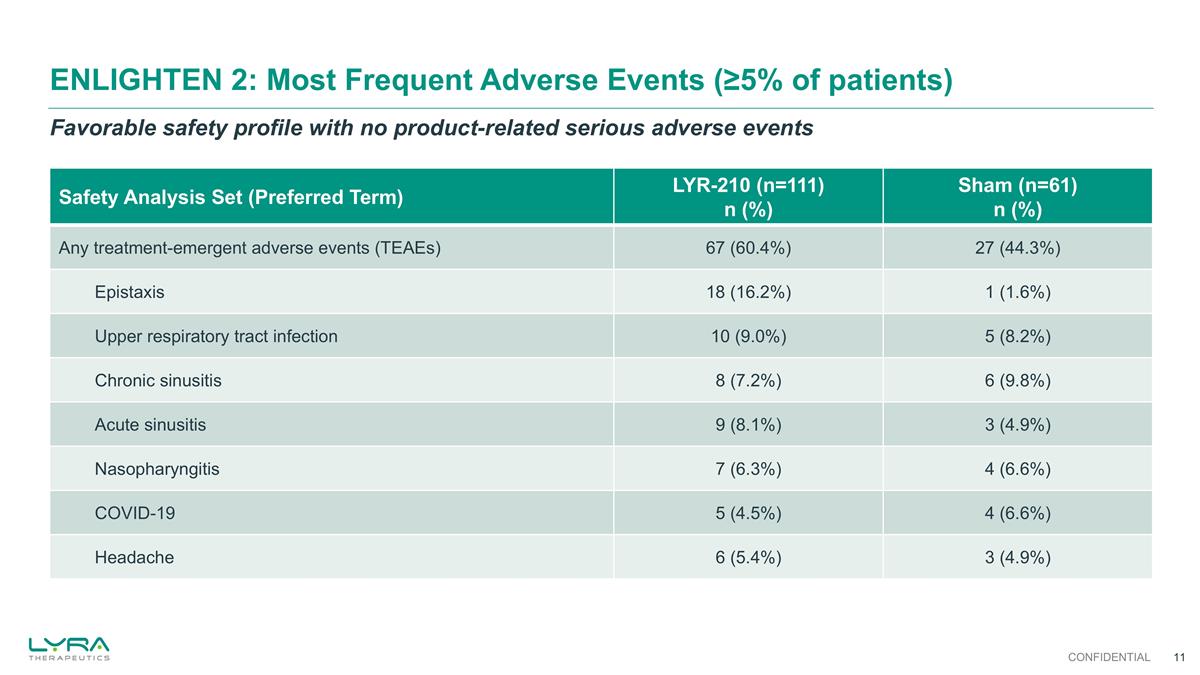
ENLIGHTEN 2: Most Frequent Adverse Events (≥5% of patients) Safety Analysis Set (Preferred Term) LYR-210 (n=111) n (%) Sham (n=61) n (%) Any treatment-emergent adverse events (TEAEs) 67 (60.4%) 27 (44.3%) Epistaxis 18 (16.2%) 1 (1.6%) Upper respiratory tract infection 10 (9.0%) 5 (8.2%) Chronic sinusitis 8 (7.2%) 6 (9.8%) Acute sinusitis 9 (8.1%) 3 (4.9%) Nasopharyngitis 7 (6.3%) 4 (6.6%) COVID-19 5 (4.5%) 4 (6.6%) Headache 6 (5.4%) 3 (4.9%) Favorable safety profile with no product-related serious adverse events CONFIDENTIAL
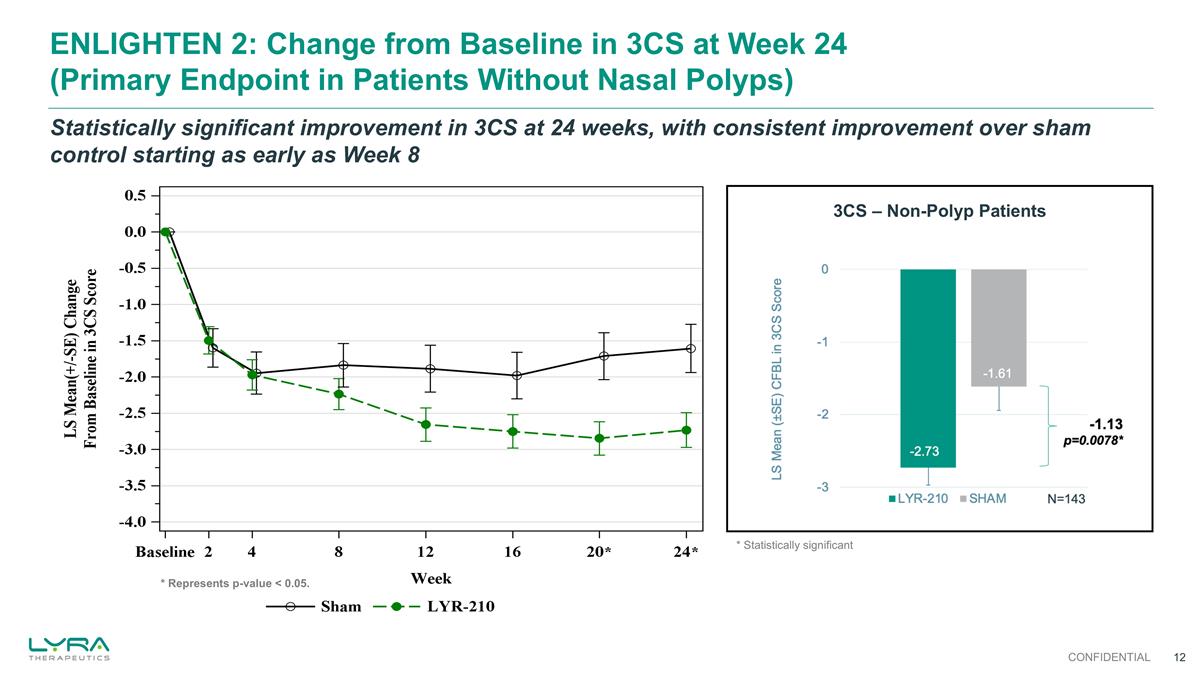
ENLIGHTEN 2: Change from Baseline in 3CS at Week 24 (Primary Endpoint in Patients Without Nasal Polyps) Statistically significant improvement in 3CS at 24 weeks, with consistent improvement over sham control starting as early as Week 8 * Statistically significant 3CS – Non-Polyp Patients CONFIDENTIAL * Represents p-value < 0.05.
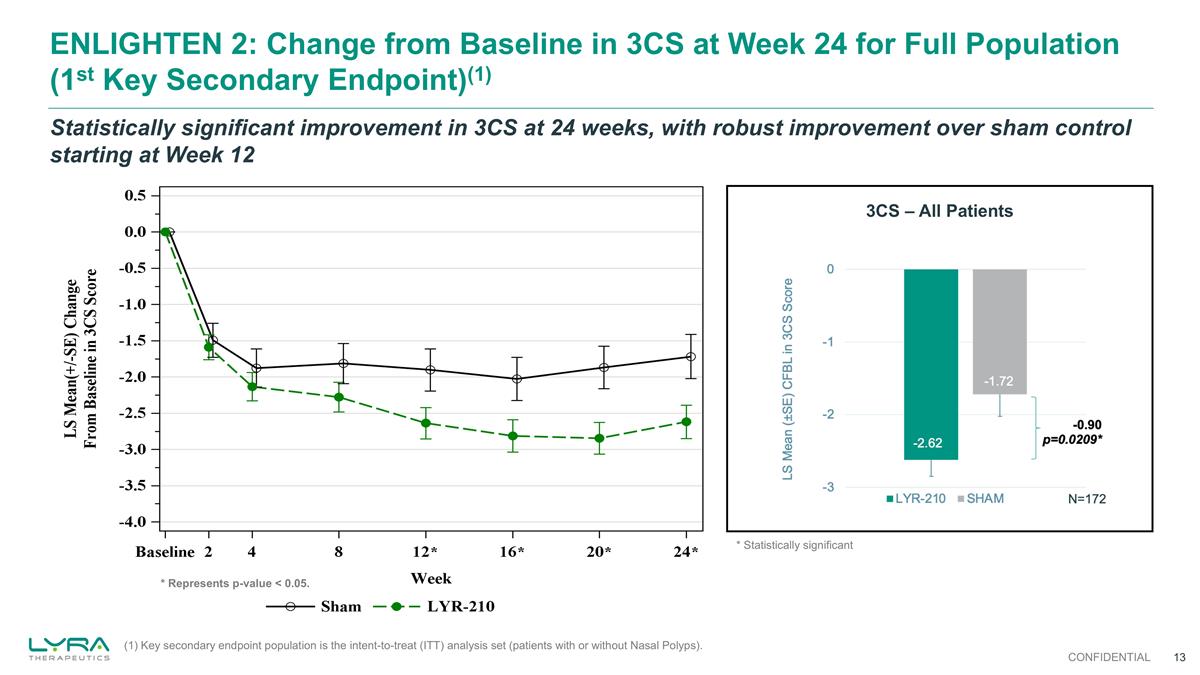
ENLIGHTEN 2: Change from Baseline in 3CS at Week 24 for Full Population (1st Key Secondary Endpoint)(1) Statistically significant improvement in 3CS at 24 weeks, with robust improvement over sham control starting at Week 12 (1) Key secondary endpoint population is the intent-to-treat (ITT) analysis set (patients with or without Nasal Polyps). 3CS – All Patients CONFIDENTIAL * Statistically significant * Represents p-value < 0.05.
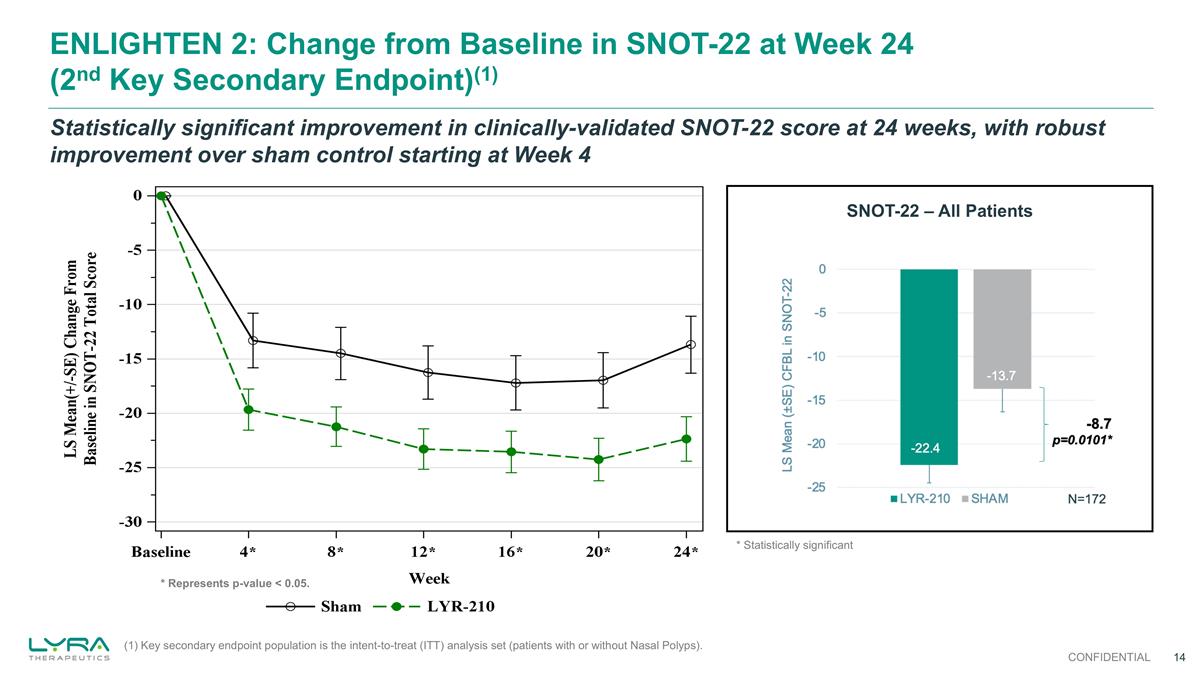
ENLIGHTEN 2: Change from Baseline in SNOT-22 at Week 24 (2nd Key Secondary Endpoint)(1) Statistically significant improvement in clinically-validated SNOT-22 score at 24 weeks, with robust improvement over sham control starting at Week 4 (1) Key secondary endpoint population is the intent-to-treat (ITT) analysis set (patients with or without Nasal Polyps). SNOT-22 – All Patients CONFIDENTIAL * Statistically significant * Represents p-value < 0.05.
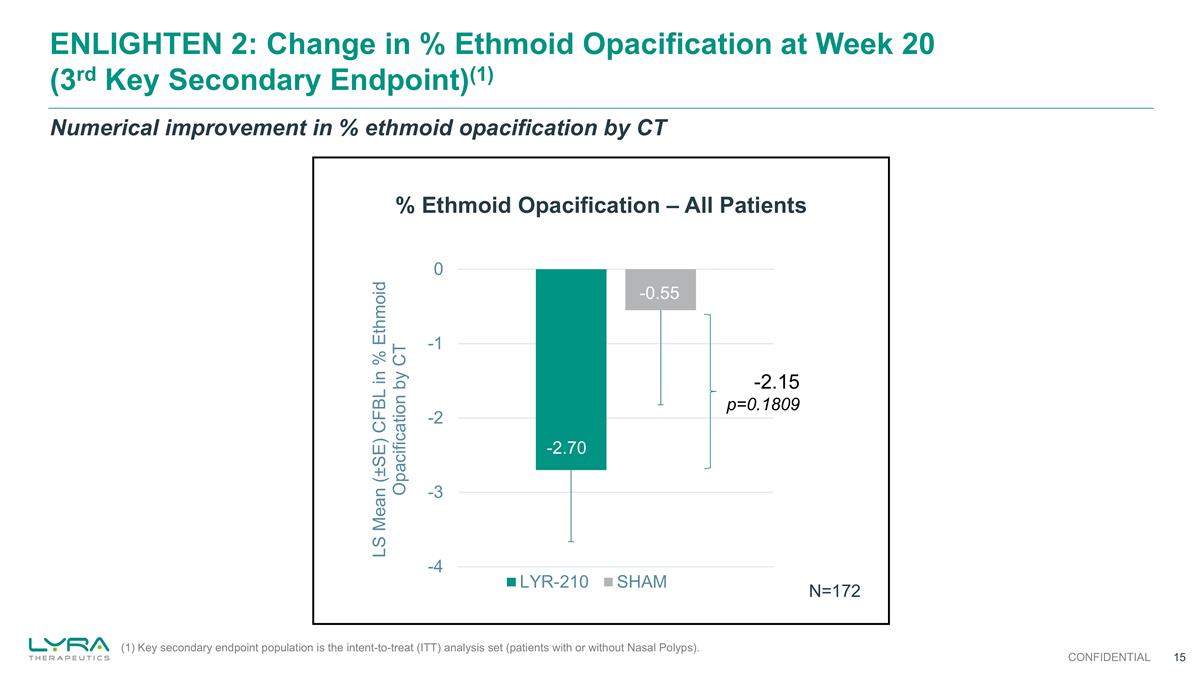
ENLIGHTEN 2: Change in % Ethmoid Opacification at Week 20 (3rd Key Secondary Endpoint)(1) N=172 Numerical improvement in % ethmoid opacification by CT (1) Key secondary endpoint population is the intent-to-treat (ITT) analysis set (patients with or without Nasal Polyps). % Ethmoid Opacification – All Patients CONFIDENTIAL
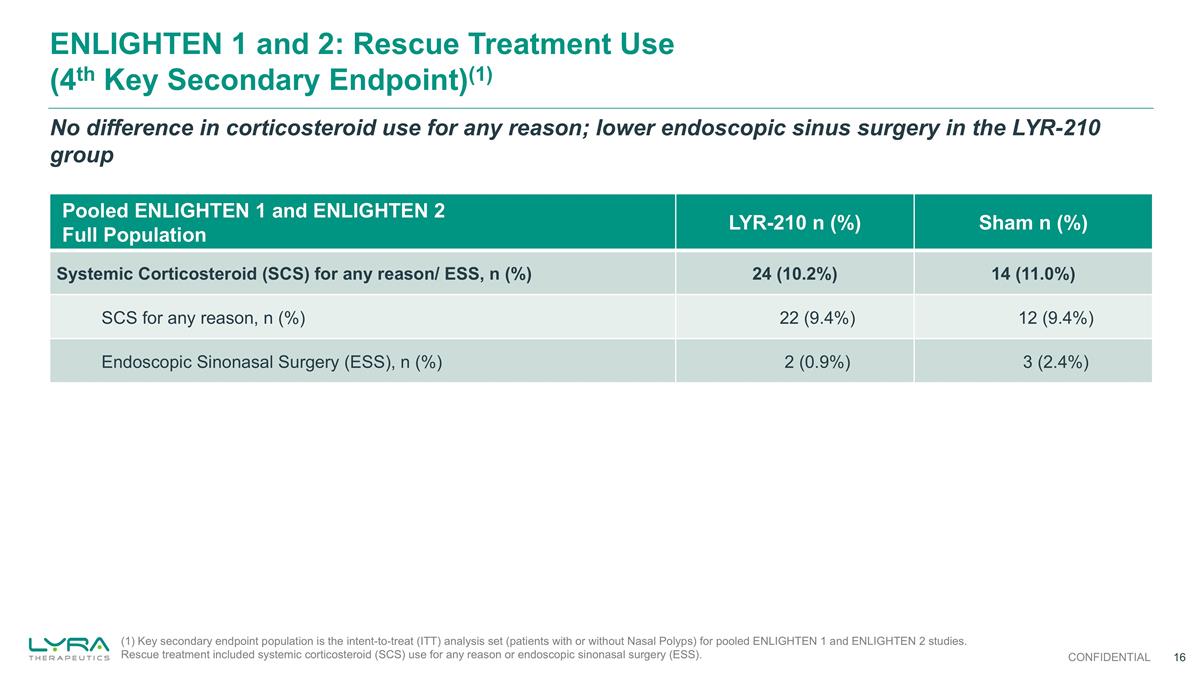
ENLIGHTEN 1 and 2: Rescue Treatment Use (4th Key Secondary Endpoint)(1) Pooled ENLIGHTEN 1 and ENLIGHTEN 2 Full Population LYR-210 n (%) Sham n (%) Systemic Corticosteroid (SCS) for any reason/ ESS, n (%) 24 (10.2%) 14 (11.0%) SCS for any reason, n (%) 22 (9.4%) 12 (9.4%) Endoscopic Sinonasal Surgery (ESS), n (%) 2 (0.9%) 3 (2.4%) No difference in corticosteroid use for any reason; lower endoscopic sinus surgery in the LYR-210 group (1) Key secondary endpoint population is the intent-to-treat (ITT) analysis set (patients with or without Nasal Polyps) for pooled ENLIGHTEN 1 and ENLIGHTEN 2 studies. Rescue treatment included systemic corticosteroid (SCS) use for any reason or endoscopic sinonasal surgery (ESS). CONFIDENTIAL
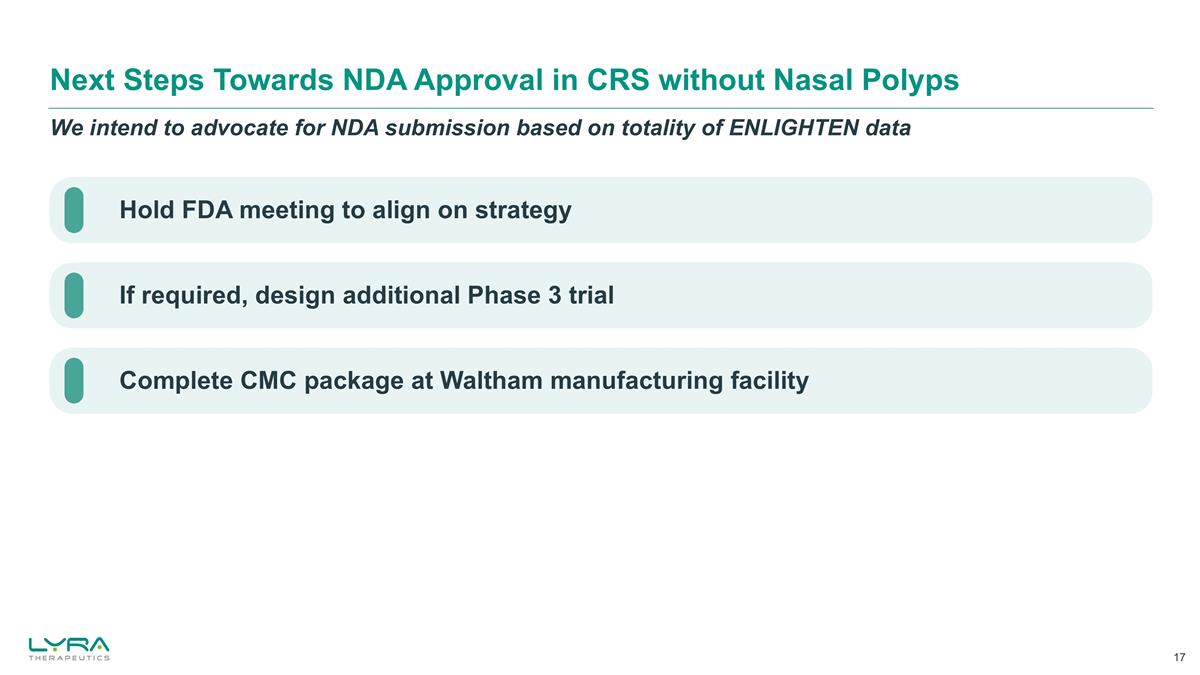
We intend to advocate for NDA submission based on totality of ENLIGHTEN data Next Steps Towards NDA Approval in CRS without Nasal Polyps If required, design additional Phase 3 trial Hold FDA meeting to align on strategy Complete CMC package at Waltham manufacturing facility
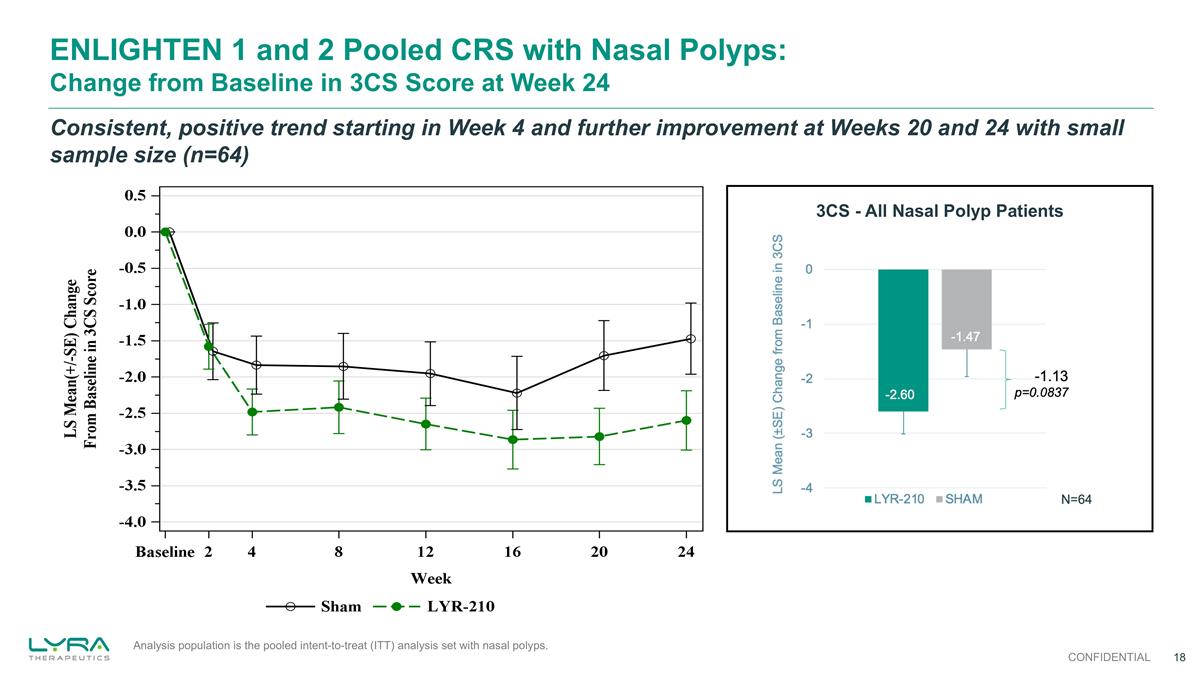
ENLIGHTEN 1 and 2 Pooled CRS with Nasal Polyps: Change from Baseline in 3CS Score at Week 24 CONFIDENTIAL Consistent, positive trend starting in Week 4 and further improvement at Weeks 20 and 24 with small sample size (n=64) Analysis population is the pooled intent-to-treat (ITT) analysis set with nasal polyps. 3CS - All Nasal Polyp Patients
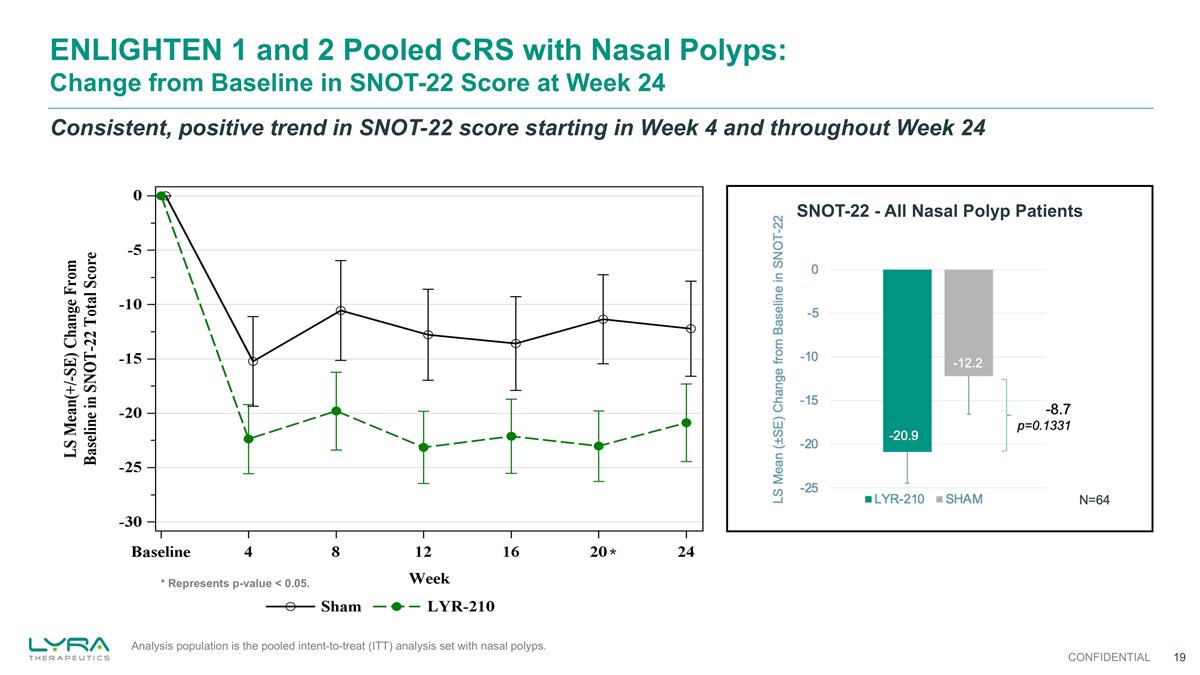
ENLIGHTEN 1 and 2 Pooled CRS with Nasal Polyps: Change from Baseline in SNOT-22 Score at Week 24 CONFIDENTIAL * Consistent, positive trend in SNOT-22 score starting in Week 4 and throughout Week 24 SNOT-22 - All Nasal Polyp Patients Analysis population is the pooled intent-to-treat (ITT) analysis set with nasal polyps. * Represents p-value < 0.05.
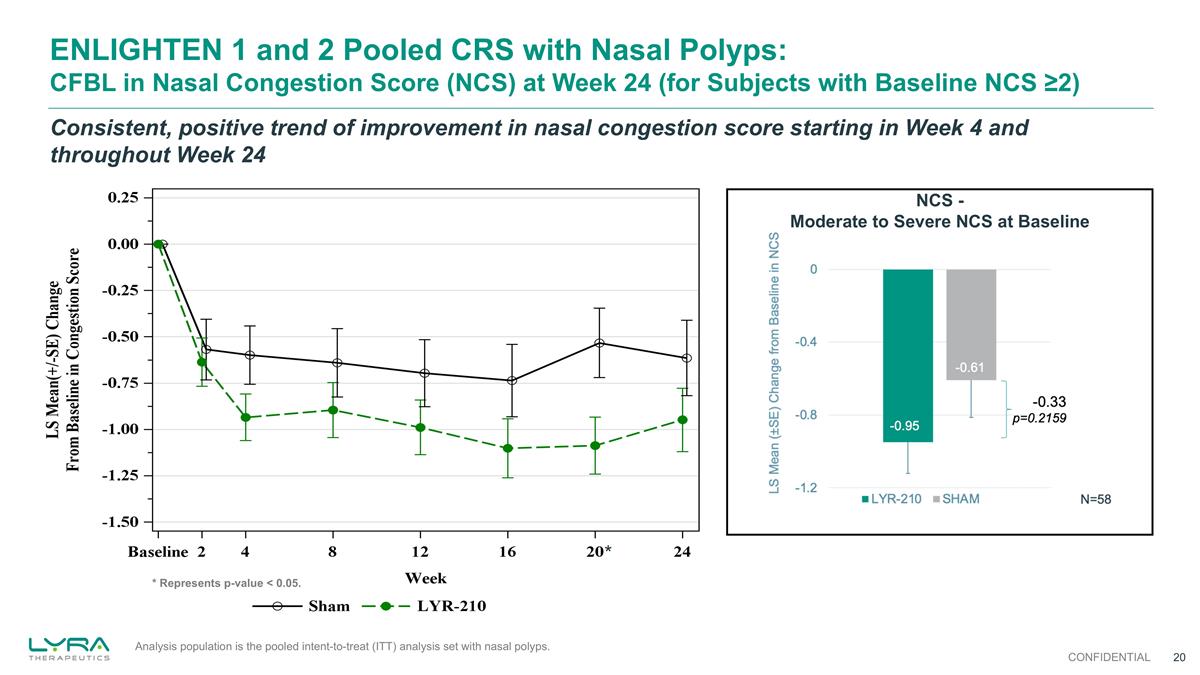
ENLIGHTEN 1 and 2 Pooled CRS with Nasal Polyps: CFBL in Nasal Congestion Score (NCS) at Week 24 (for Subjects with Baseline NCS ≥2) CONFIDENTIAL Consistent, positive trend of improvement in nasal congestion score starting in Week 4 and throughout Week 24 NCS - Moderate to Severe NCS at Baseline Analysis population is the pooled intent-to-treat (ITT) analysis set with nasal polyps. * Represents p-value < 0.05. * * Represents p-value < 0.05.
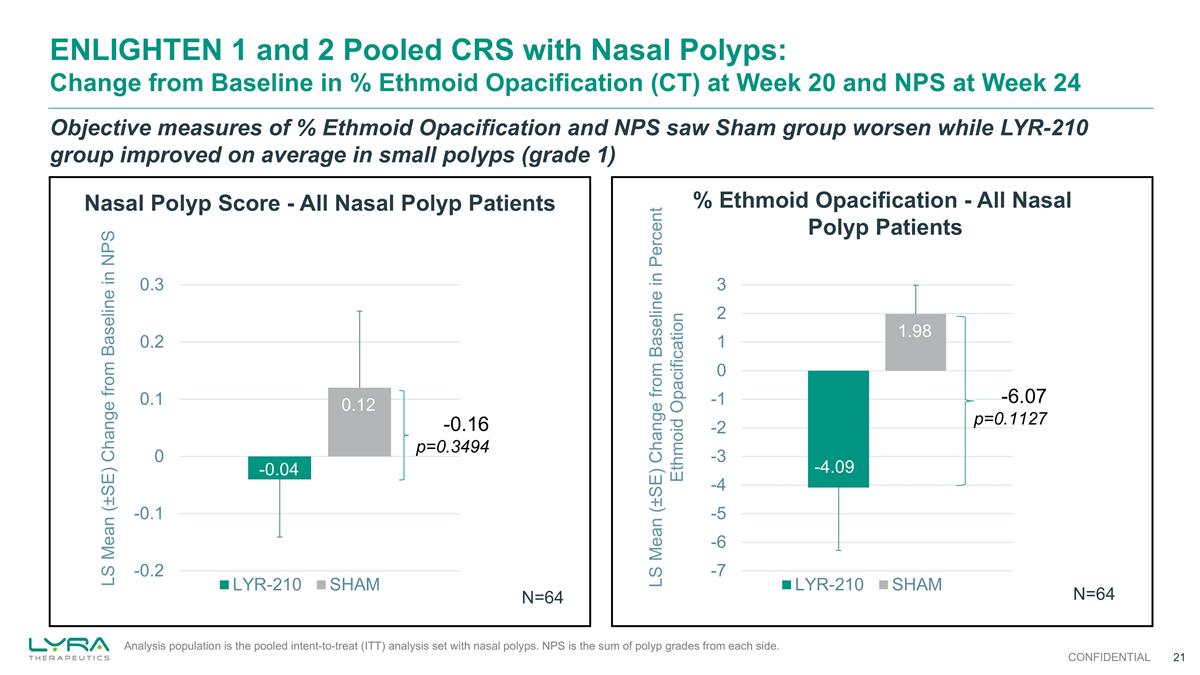
ENLIGHTEN 1 and 2 Pooled CRS with Nasal Polyps: Change from Baseline in % Ethmoid Opacification (CT) at Week 20 and NPS at Week 24 CONFIDENTIAL Objective measures of % Ethmoid Opacification and NPS saw Sham group worsen while LYR-210 group improved on average in small polyps (grade 1) Analysis population is the pooled intent-to-treat (ITT) analysis set with nasal polyps. NPS is the sum of polyp grades from each side. N=64 LS Mean (±SE) Change from Baseline in NPS N=64 LS Mean (±SE) Change from Baseline in Percent Ethmoid Opacification Nasal Polyp Score - All Nasal Polyp Patients % Ethmoid Opacification - All Nasal Polyp Patients
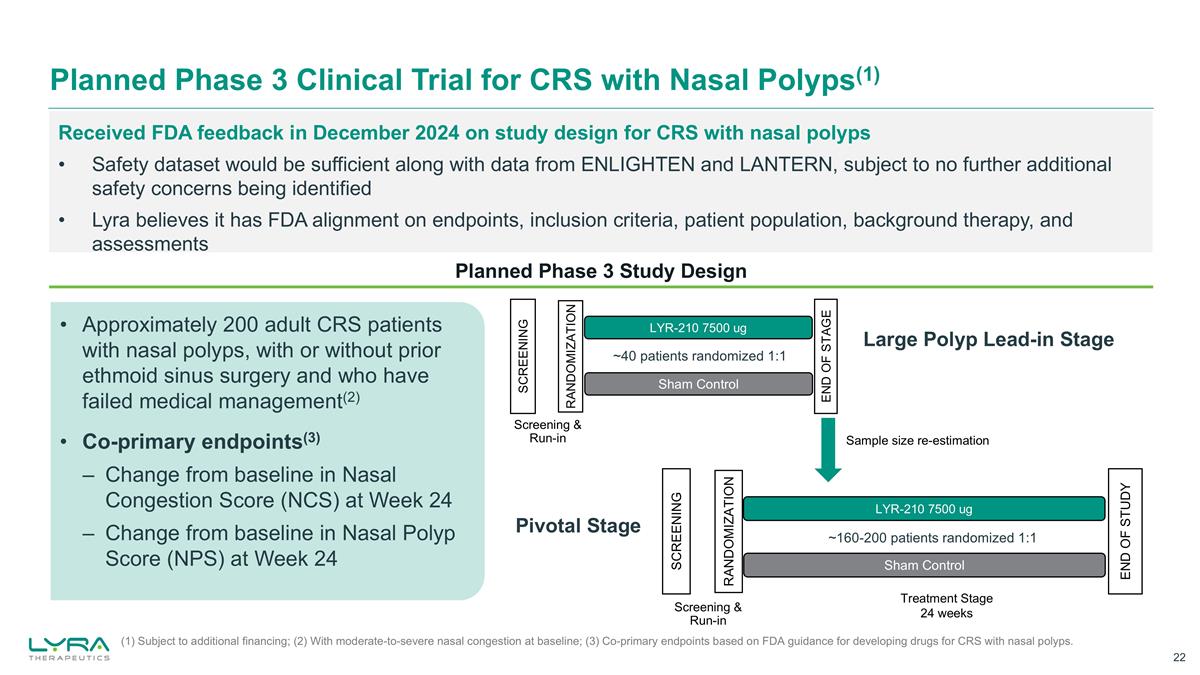
Planned Phase 3 Clinical Trial for CRS with Nasal Polyps(1) Received FDA feedback in December 2024 on study design for CRS with nasal polyps Safety dataset would be sufficient along with data from ENLIGHTEN and LANTERN, subject to no further additional safety concerns being identified Lyra believes it has FDA alignment on endpoints, inclusion criteria, patient population, background therapy, and assessments Planned Phase 3 Study Design Approximately 200 adult CRS patients with nasal polyps, with or without prior ethmoid sinus surgery and who have failed medical management(2) Co-primary endpoints(3) Change from baseline in Nasal Congestion Score (NCS) at Week 24 Change from baseline in Nasal Polyp Score (NPS) at Week 24 Sham Control LYR-210 7500 ug SCREENING RANDOMIZATION END OF STUDY Treatment Stage 24 weeks Screening & Run-in ~160-200 patients randomized 1:1 Sham Control LYR-210 7500 ug SCREENING RANDOMIZATION END OF STAGE Screening & Run-in ~40 patients randomized 1:1 Sample size re-estimation Large Polyp Lead-in Stage Pivotal Stage (1) Subject to additional financing; (2) With moderate-to-severe nasal congestion at baseline; (3) Co-primary endpoints based on FDA guidance for developing drugs for CRS with nasal polyps.
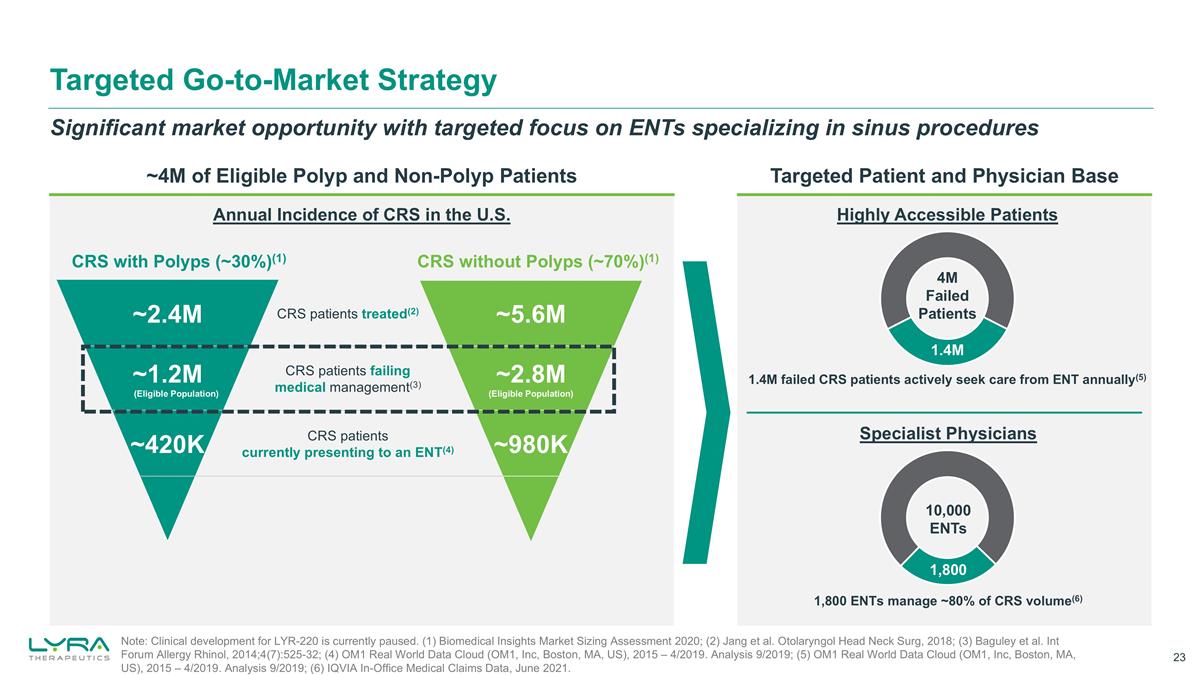
Targeted Go-to-Market Strategy Specialist Physicians 1,800 ENTs manage ~80% of CRS volume(6) 1,800 10,000 ENTs Significant market opportunity with targeted focus on ENTs specializing in sinus procedures Highly Accessible Patients 1.4M failed CRS patients actively seek care from ENT annually(5) 4M Failed Patients 1.4M CRS patients treated(2) CRS patients failing medical management(3) CRS patients currently presenting to an ENT(4) ~5.6M ~2.8M (Eligible Population) ~980K CRS without Polyps (~70%)(1) ~2.4M ~420K ~1.2M (Eligible Population) CRS with Polyps (~30%)(1) Targeted Patient and Physician Base ~4M of Eligible Polyp and Non-Polyp Patients Annual Incidence of CRS in the U.S. Note: Clinical development for LYR-220 is currently paused. (1) Biomedical Insights Market Sizing Assessment 2020; (2) Jang et al. Otolaryngol Head Neck Surg, 2018; (3) Baguley et al. Int Forum Allergy Rhinol, 2014;4(7):525-32; (4) OM1 Real World Data Cloud (OM1, Inc, Boston, MA, US), 2015 – 4/2019. Analysis 9/2019; (5) OM1 Real World Data Cloud (OM1, Inc, Boston, MA, US), 2015 – 4/2019. Analysis 9/2019; (6) IQVIA In-Office Medical Claims Data, June 2021.
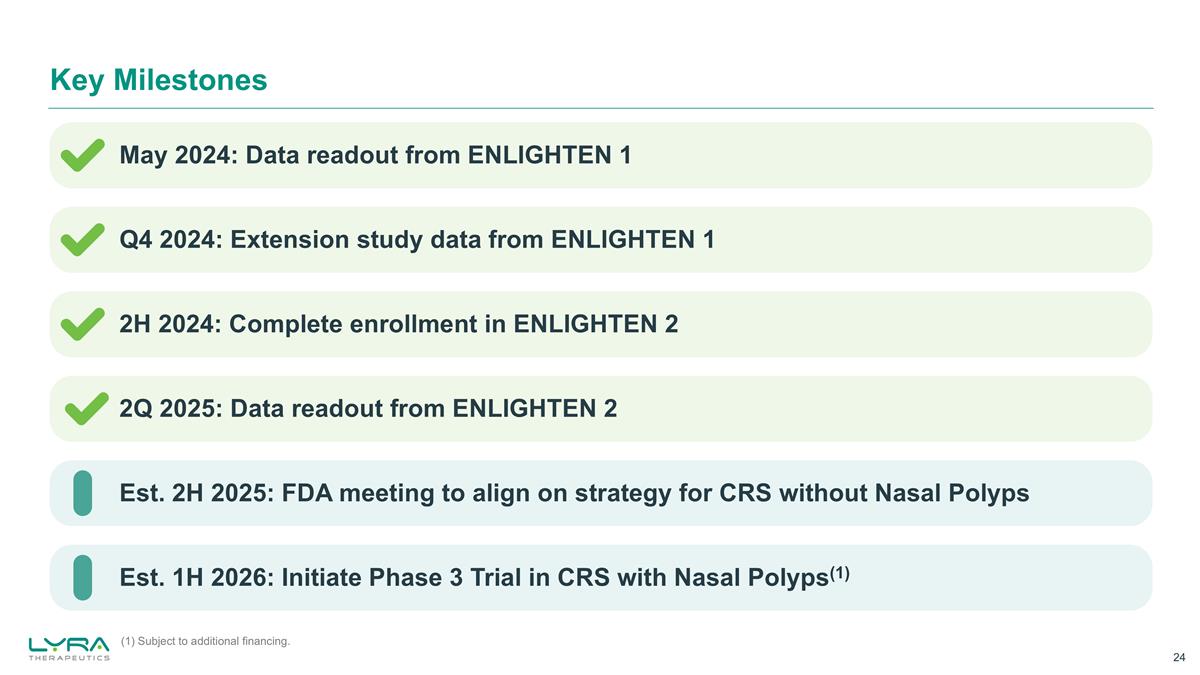
Key Milestones May 2024: Data readout from ENLIGHTEN 1 Q4 2024: Extension study data from ENLIGHTEN 1 2H 2024: Complete enrollment in ENLIGHTEN 2 2Q 2025: Data readout from ENLIGHTEN 2 Est. 1H 2026: Initiate Phase 3 Trial in CRS with Nasal Polyps(1) Est. 2H 2025: FDA meeting to align on strategy for CRS without Nasal Polyps (1) Subject to additional financing.
